Art History Midterm
1/32
There's no tags or description
Looks like no tags are added yet.
Name | Mastery | Learn | Test | Matching | Spaced |
|---|
No study sessions yet.
33 Terms
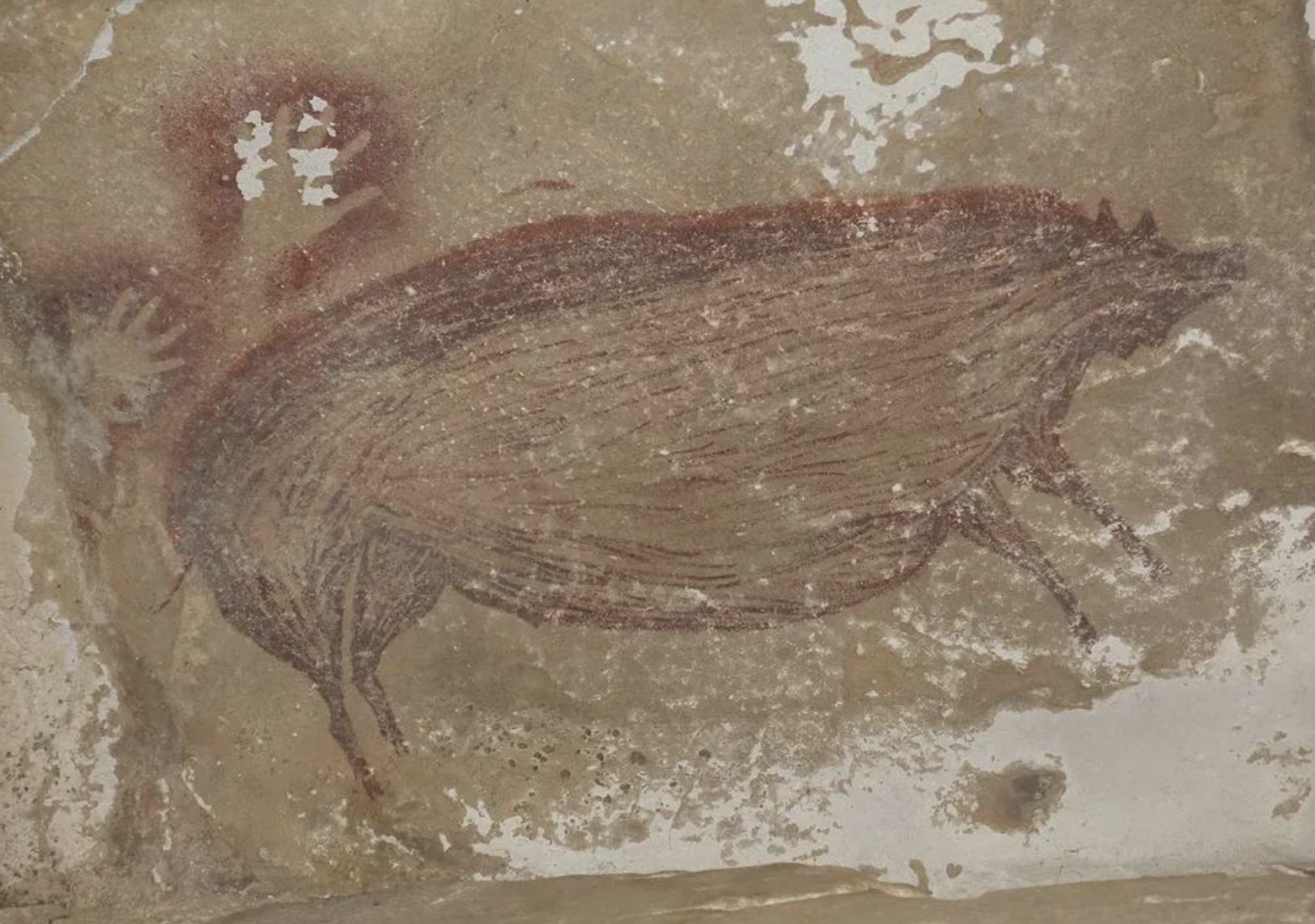
Warty Pig, IndonesiaThe Warty Pig is a prehistoric figurative artwork dating back to around 45,500 BCE. It is related to early human rituals and symbolizes themes such as fertility and hunting.
Medium: Ochre pigment on limestone cave wall
Date: c. 45,500 BCE
Context: Considered the oldest known figurative art. Found in a remote cave in Indonesia.
Period: Paleolithic (Prehistoric)
Subject Matter: A warty pig, native to the region.
Purpose: Possibly religious or magical, related to hunting practices or ancestral worship.
Iconography: Animal form may symbolize fertility, hunting success, or spiritual guardianship.
Comparison: Similar in function and style to Hall of Bulls, Lascaux and Megaloceros Gallery, Spain - early animal representations with symbolic meanings.
Popular Interpretations: The hands depict the capturing and luring of the animal. Viewed as evidence of symbolic thinking and the development of cognitive capabilities.
Significance: Challenges Eurocentric views of where early art emerged; shows global roots of human creativity.
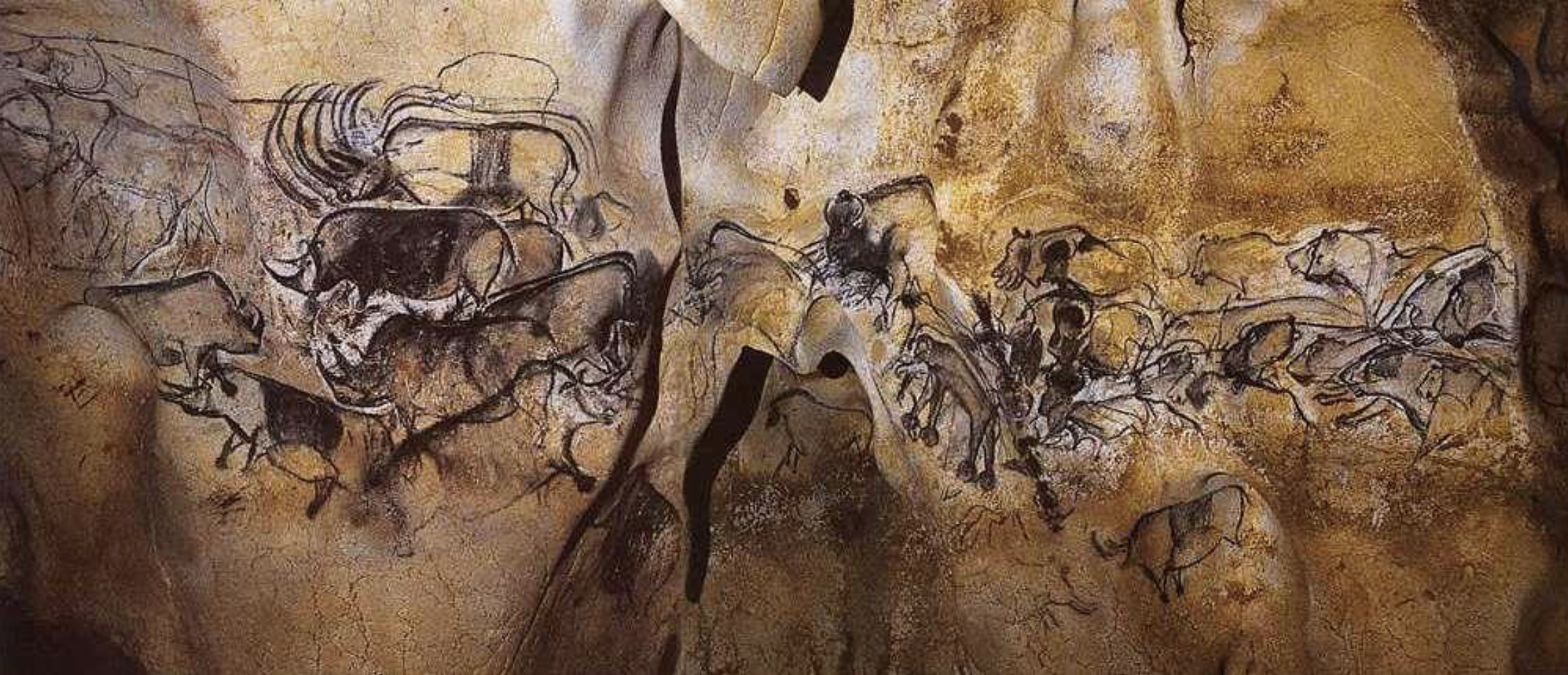
Megaloceros Gallery, Chauvet Cave, France is a prehistoric cave painting known for its depictions of giant deer and sophisticated artistic techniques.
Title: Megaloceros Gallery
Medium: Paint on limestone
Date: c. 30,000 – 28,000 BCE
Context: One of the earliest known cave painting sites.
Period: Upper Paleolithic
Subject Matter: Giant deer (Megaloceros), among other animals.
Purpose: Likely ritualistic, possibly tied to hunting magic or storytelling.
Comparison: More sophisticated in shading and (dynamic) movement than Hall of Bulls, Lascaux.
Interpretations: Possible connection to early mythologies.
Significance: Demonstrates advanced artistic techniques for the time

Hall of Bulls, France is a notable prehistoric cave painting site famous for its vivid representations of bulls and other animals, demonstrating significant artistic and cultural development during the Upper Paleolithic period.
Title: Hall of Bulls
Medium: Paint on limestone
Date: c. 15,000 BCE
Context: Located in a complex network of cave systems.
Period: Upper Paleolithic
Subject Matter: Bulls, horses, and other animals in motion.
Purpose: Possibly to ensure a successful hunt or spiritual guidance.
Iconography: Emphasis on animal power and movement; may reflect clan identity.
Comparison: One of the most famous examples of cave painting; related to Chauvet in terms of intent but more dynamic.
Interpretations: Seen as early form of proto-cinema due to overlapping figures.
Significance: Masterpiece of prehistoric art; reveals early narrative impulses.
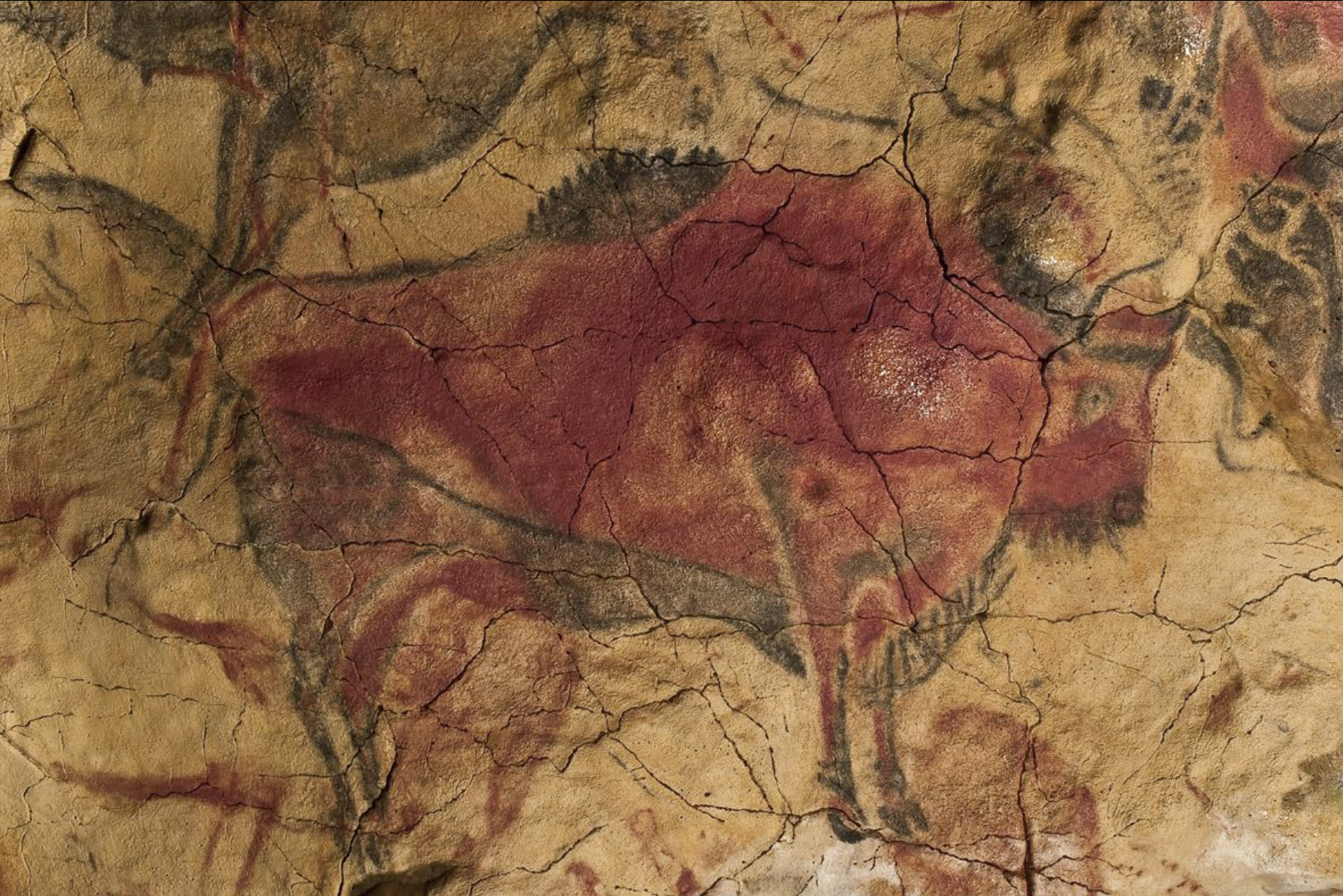
Steppe Bison, Spain is a celebrated prehistoric art site featuring depictions of bison and advanced artistic techniques, significant for understanding Upper Paleolithic culture.
Title: Steppe Bison
Medium: Charcoal and ocher
Date: c. 12,000–11,000 BCE
Context: Discovered in a cave famous for its vivid ceiling paintings.
Period: Upper Paleolithic
Subject Matter: Bison
Purpose: Possibly magical or ritual function.
Iconography: Strength, fertility, and the hunt.
Comparison: Similar style to Hall of Bulls, Lascaux.
Interpretations: May reflect a complex belief system involving animal spirits.
Significance: Showcases the continuity of animal worship/symbolism.
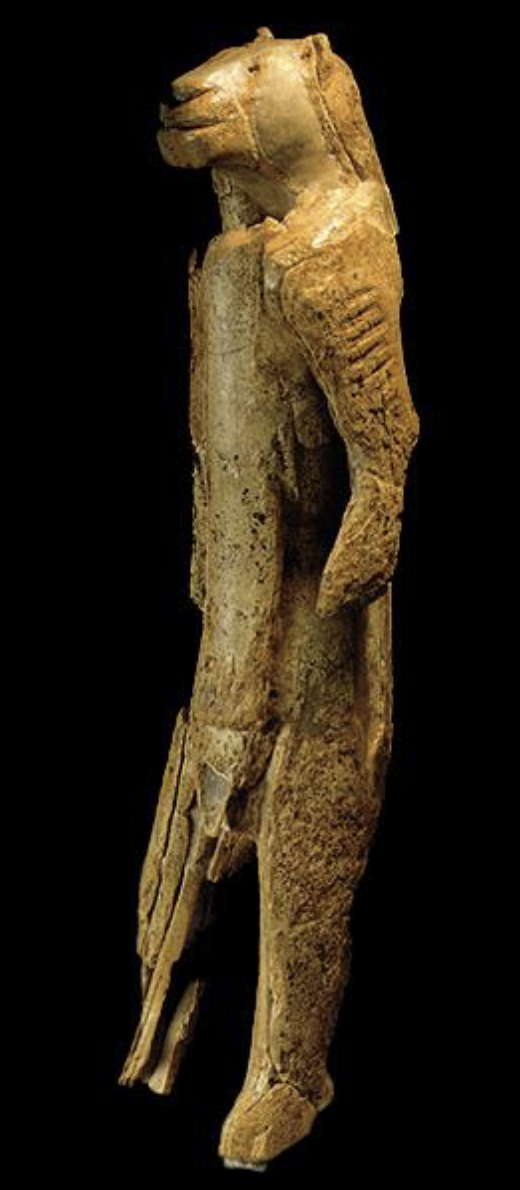
Löwenmensch (Lion-Human Figurine) is a prehistoric sculpture that depicts a humanoid figure with lion features, symbolizing potential religious or mythological significance.
Title: Lion-Human Figurine
Medium: Mammoth ivory
Date: c. 40,000–35,000 BCE
Context: Found in Hohlenstein-Stadel cave in Germany.
Period: Paleolithic
Subject Matter: Anthropomorphic figure combining human and lion traits.
Purpose: Possibly religious or mythological.
Iconography: Hybrid form = symbolic transformation or deity.
Comparison: Precursor to later mythological hybrids like the sphinx.
Interpretations: May represent a god, totem, or spiritual transformation.
Significance: One of the oldest known sculptures; suggests complex belief systems.
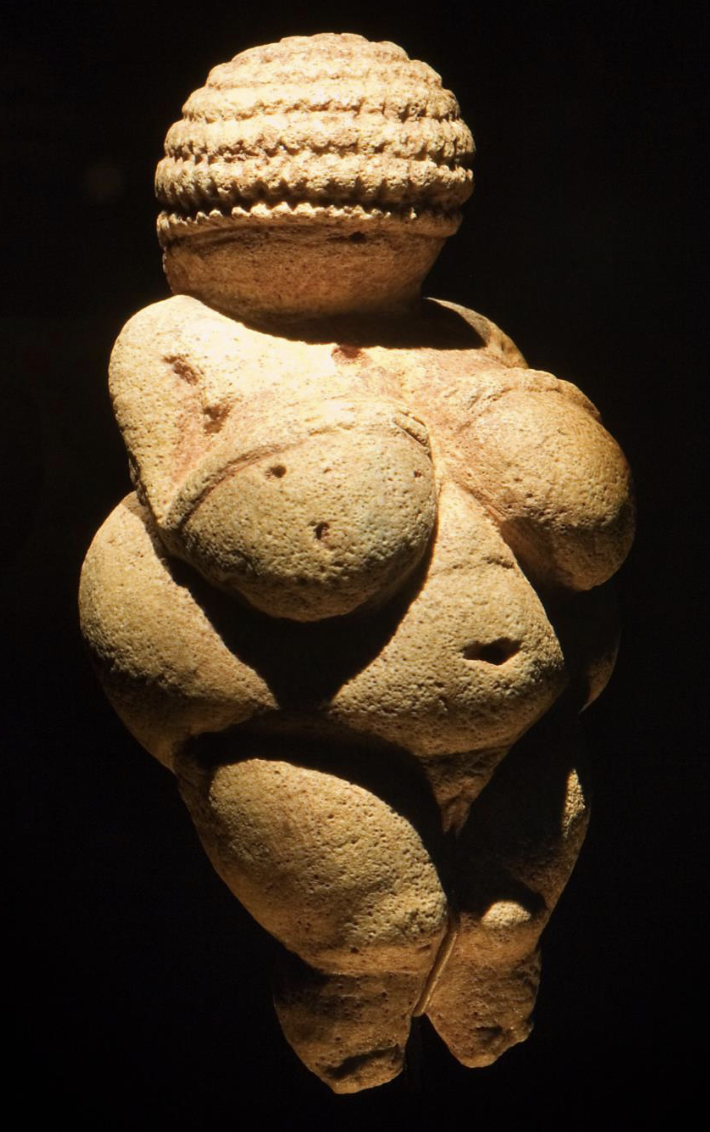
Woman/ Venus of Willendorf
Title: Woman (or Venus) of Willendorf
Medium: Limestone with red ochre. Formed around the bellybutton.
Date: c. 24,000–22,000 BCE
Context: Found in Austria; often linked with fertility.
Period: Paleolithic
Subject Matter: Exaggerated female figure
Purpose: Fertility symbol, charm, or ancestor figure.
Iconography: Enlarged breasts and hips = fertility, nourishment, life.
Interpretations: Feminist readings suggest it was a self-representation, looking from the top down.
Significance: Icon of prehistoric art and fertility worship
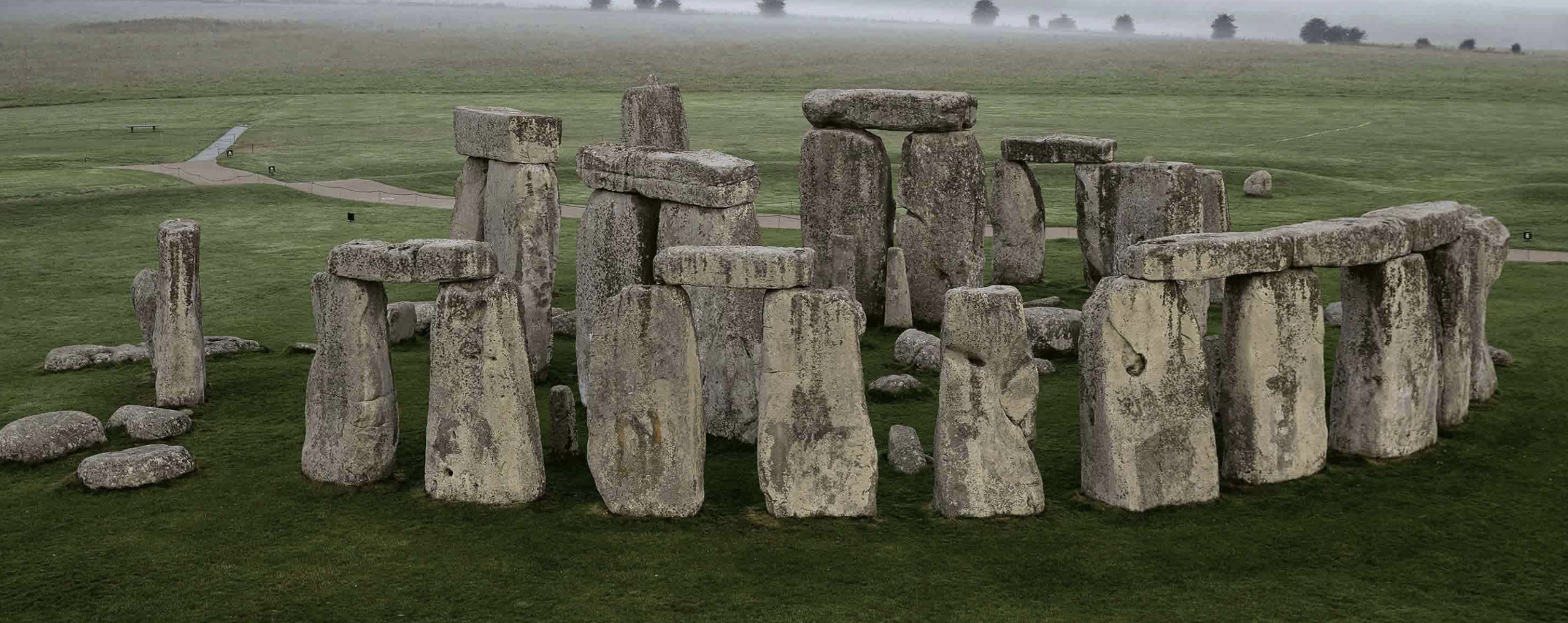
Stonehenge, Wiltshire, England
Architect: Unknown
Title: Stonehenge
Medium: Sandstone and bluestone. Post and Lintel
Date: c. 2900–1500 BCE
Context: Monumental stone circle aligned with solstices.
Period: Neolithic to Bronze Age transition
Commissioned by: Likely local religious/political elites.
Subject Matter: Megalithic circle
Purpose: Ceremonial, astronomical, possibly burial.
Iconography: Solar alignment hints at cosmological understanding.
Comparison: Related to Newgrange and other megalithic sites.
Interpretations: May symbolize death/rebirth cycles or community gathering.
Significance: Key example of prehistoric monumentality and engineering.

Newgrange Passage Grave, Ireland
Architect: Unknown
Title: Newgrange Passage Grave
Medium: Stone with corbelled roof and spiral carvings
Date: c. 3100 BCE
Context: Neolithic tomb aligned with winter solstice sunrise.
Period: Neolithic
Subject Matter: Burial mound
Purpose: Tomb, ceremonial site, solar observatory.
Iconography: Spirals may signify life cycles, afterlife, or solar patterns.
Comparison: Older than Stonehenge and the Pyramids; more enclosed design.
Interpretations: Spiritual bridge between life and death.
Significance: Advanced architecture and astronomical precision for its time.
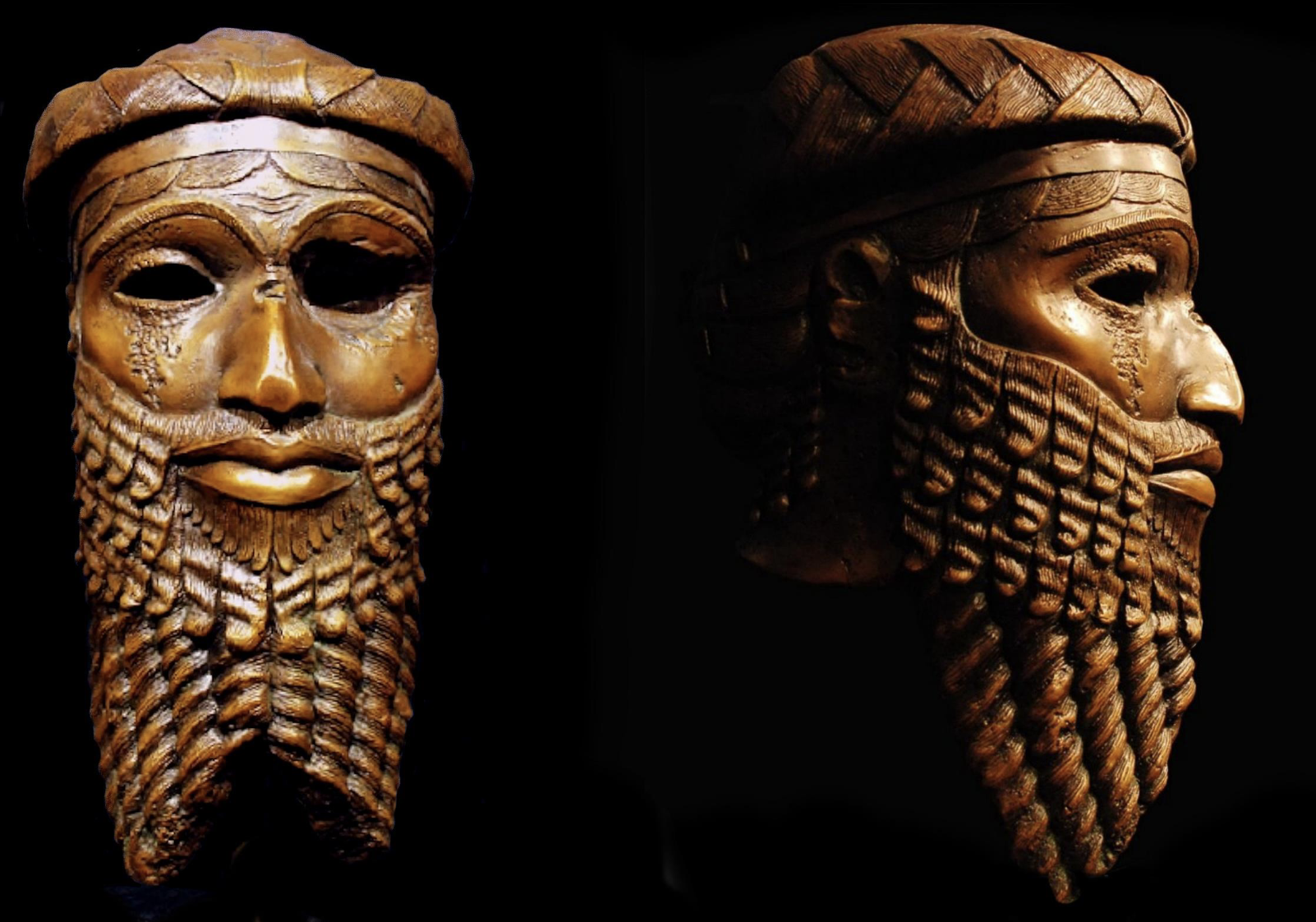
Head of an Akkadian Ruler
Artist: Unknown
Title: Head of an Akkadian Ruler (believed to be Sargon of Akkad)
Medium: Bronze
Date: c. 2250–2220 BCE
Context: From Nineveh; found deliberately mutilated.
Period: Akkadian
Commissioned by: Likely commissioned to glorify the king’s divine rule.
Subject Matter: Idealized royal portrait
Purpose: Demonstrated authority and divine kingship.
Iconography: Stylized beard and symmetrical features = power and god-like status.
Comparison: More naturalistic than earlier Sumerian votive figures.
Interpretations: Political propaganda and a representation of order and authority.
Significance: One of the earliest known life-size bronze sculptures; shows early royal portraiture and advanced metalworking.
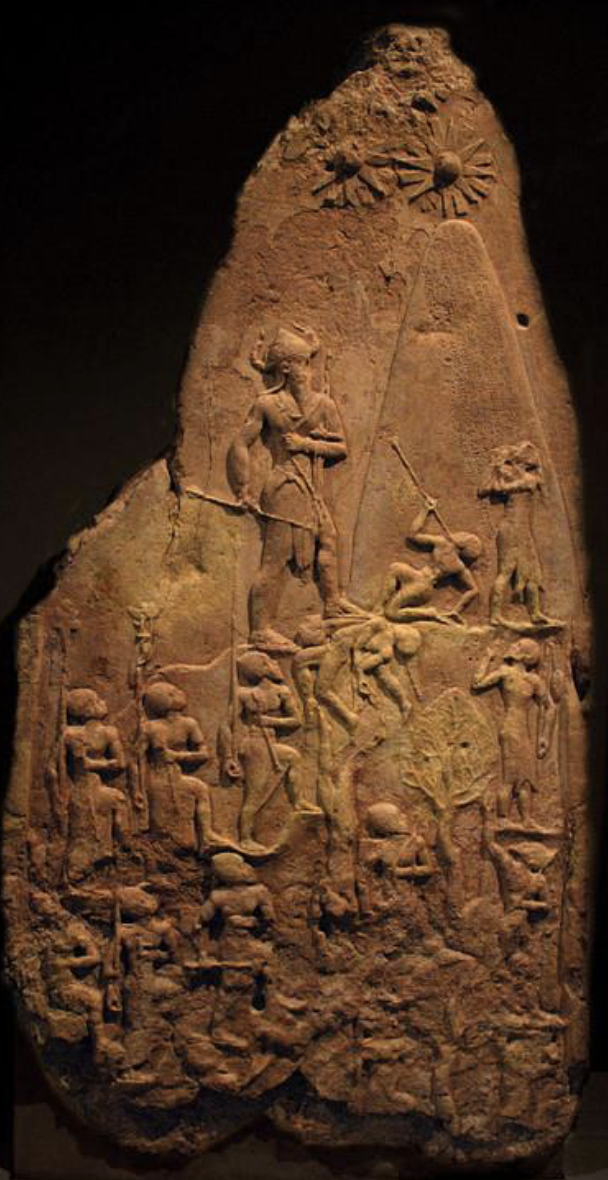
Victory Stele of Naram-Sin
Artist: Unknown
Title: Victory Stele of Naram-Sin
Medium: Limestone
Date: c. 2254–2218 BCE
Context: Celebrates Naram-Sin’s victory over the Lullubi people.
Period: Akkadian
Commissioned by: Naram-Sin himself or the Akkadian state.
Subject Matter: Triumphant king marching up a mountain, trampling enemies.
Purpose: Commemorates military victory and divine favor.
Iconography: Diagonal composition, king wearing horned helmet = divinity.
Comparison: Unusual for its dynamic diagonal layout; contrasts with horizontal registers of earlier steles.
Interpretations: Elevation of king to godlike figure. Emphasis on Heirarchical scale
Significance: Breaks from traditional narrative structure; early use of divine iconography for rulers
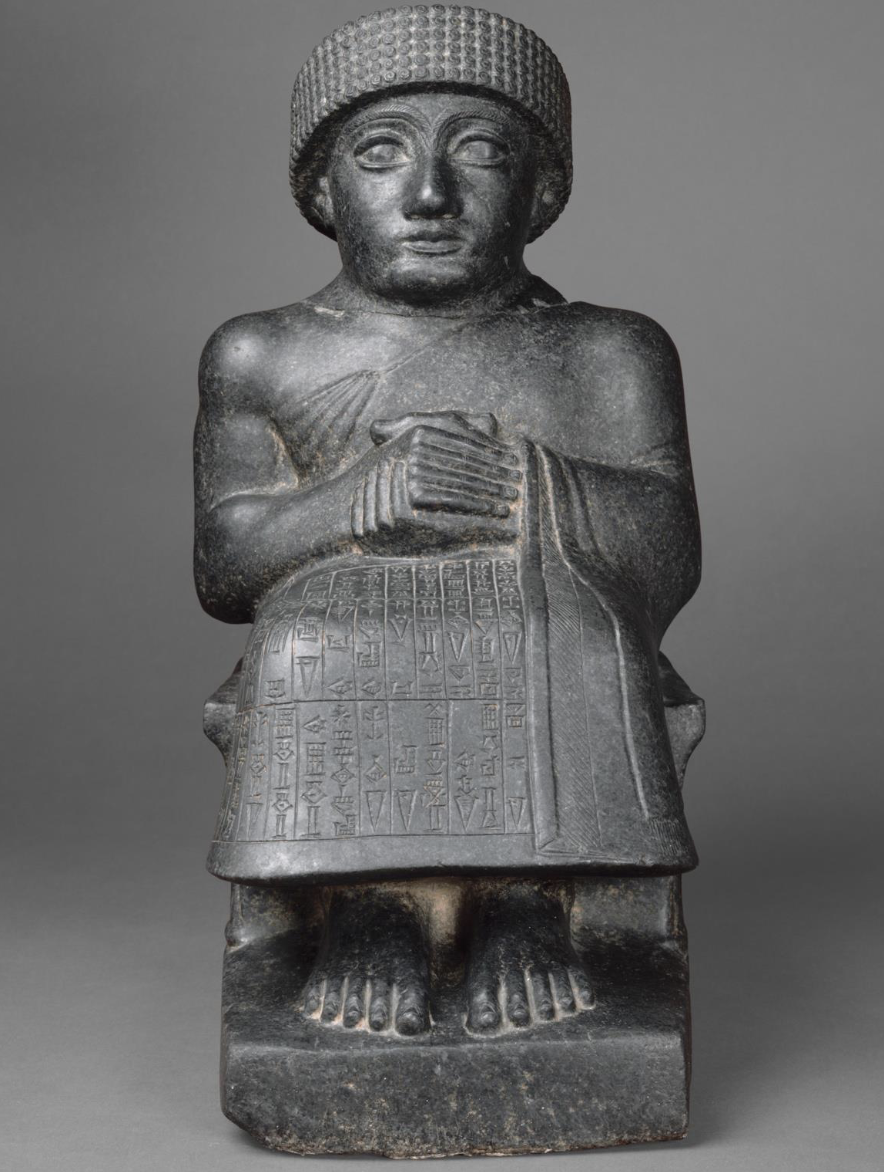
Seated Statue of Gudea
Artist: Unknown
Title: Seated Statue of Gudea
Medium: Diorite
Date: c. 2120 BCE
Context: Gudea was ruler of Lagash; many statues of him exist.
Period: Neo-Sumerian
Commissioned by: Gudea
Subject Matter: Ruler in a pose of prayer or offering
Purpose: Placed in temples to show piety and power.
Iconography: Inscribed robe with temple plans = dedication to the gods.
Comparison: More pious than Akkadian king sculptures; emphasizes ruler’s devotion.
Interpretations: Model of ideal ruler as servant of the gods.
Significance: Reflects Neo-Sumerian ideology: ruler as intermediary between gods and people.
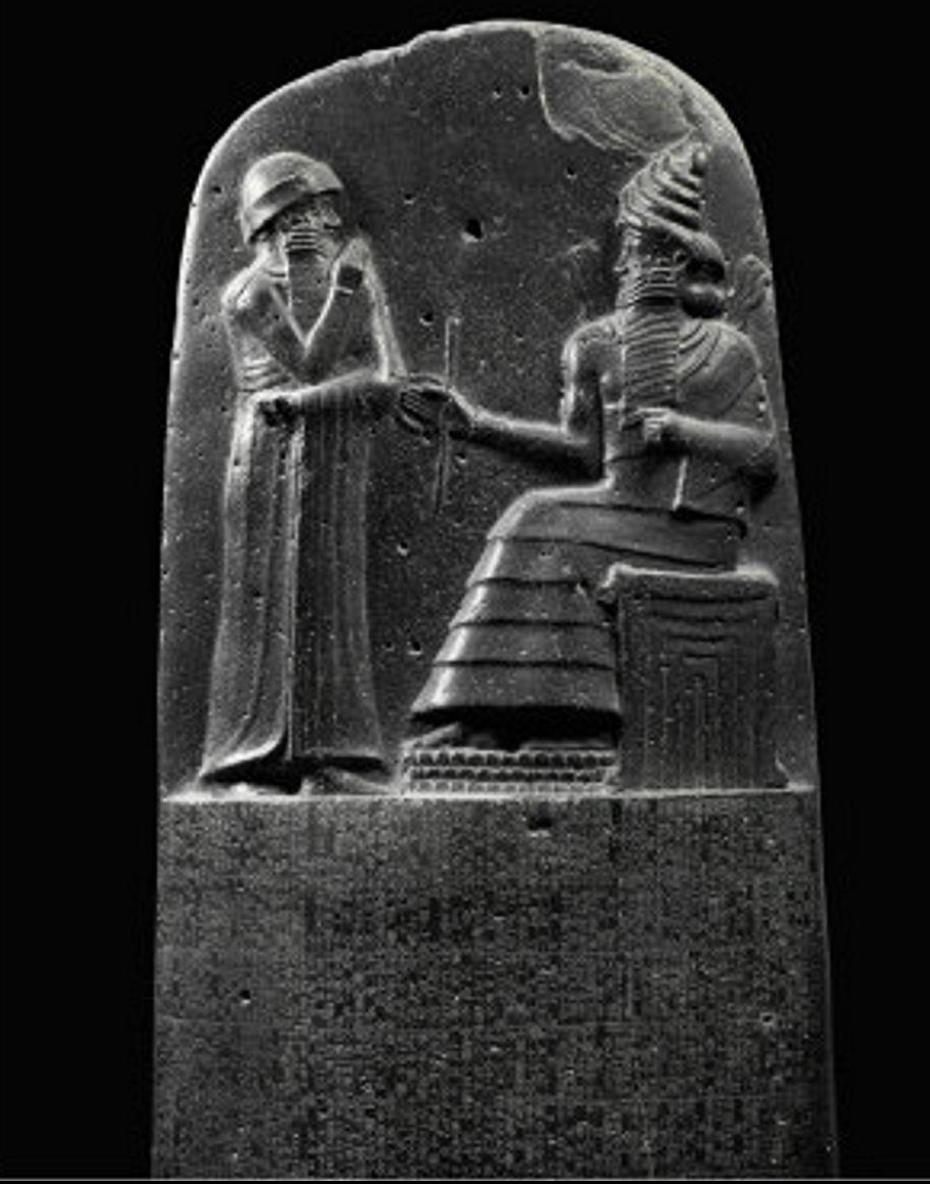
Law Stele of Hammurabi
Title: Law Stele of Hammurabi
Medium: Basalt
Date: c. 1760 BCE
Context: Found in Susa (modern-day Iran); inscribed with laws.
Period: Babylonian
Commissioned by: Hammurabi, King of Babylon
Subject Matter: Hammurabi receiving laws from Shamash, god of justice
Purpose: Public declaration of legal authority.
Iconography: Divine authority (Shamash seated on throne) legitimizing earthly ruler.
Comparison: Predecessor to all codified legal systems; blend of art and governance.
Interpretations: Rule of law rooted in divine will; shaped ideas of justice and kingship.
Significance: One of the oldest surviving law codes; early example of combining art with public governance.
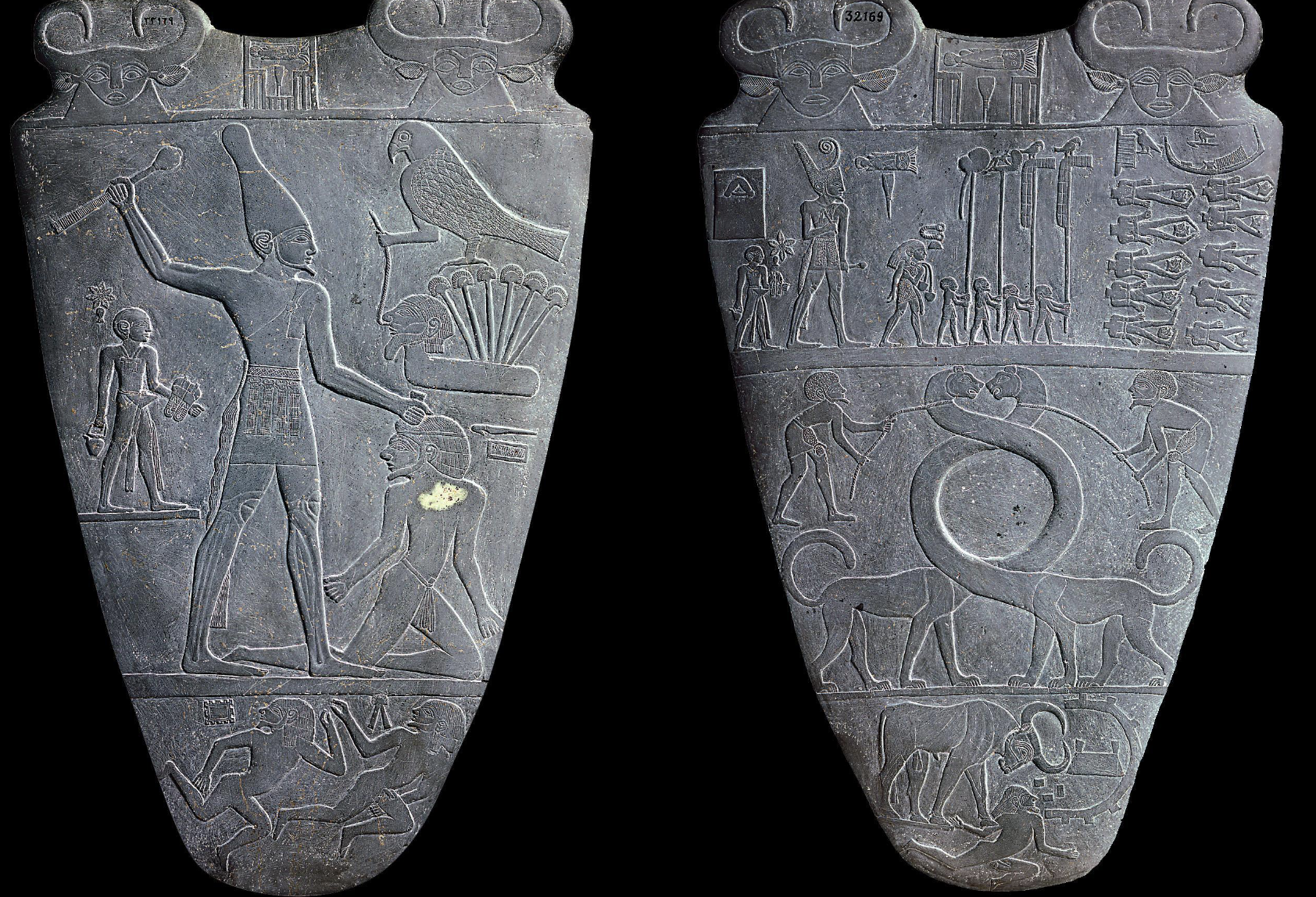
Palette of Narmer
Artist: Unknown
Title: Palette of Narmer
Medium: Graywacke (sandstone)
Date: c. 3000 BCE
Context: Ceremonial palette found at Hierakonpolis.
Period: Early Dynastic Egypt
Commissioned by: Likely created for ceremonial/religious use by the elite class.
Subject Matter: Unification of Upper and Lower Egypt under King Narmer.
Purpose: Ritual object, possibly used in temple ceremonies.
Iconography: Narmer in smiting pose, intertwined beasts (serpopards), crowns of both regions = unity, divine kingship, power.
Comparison: Proto-historical visual narrative; early use of registers.
Interpretations: Celebrates divine kingship and legitimizes political control.
Significance: One of the earliest historical documents in visual form; foundational to Egyptian visual language.
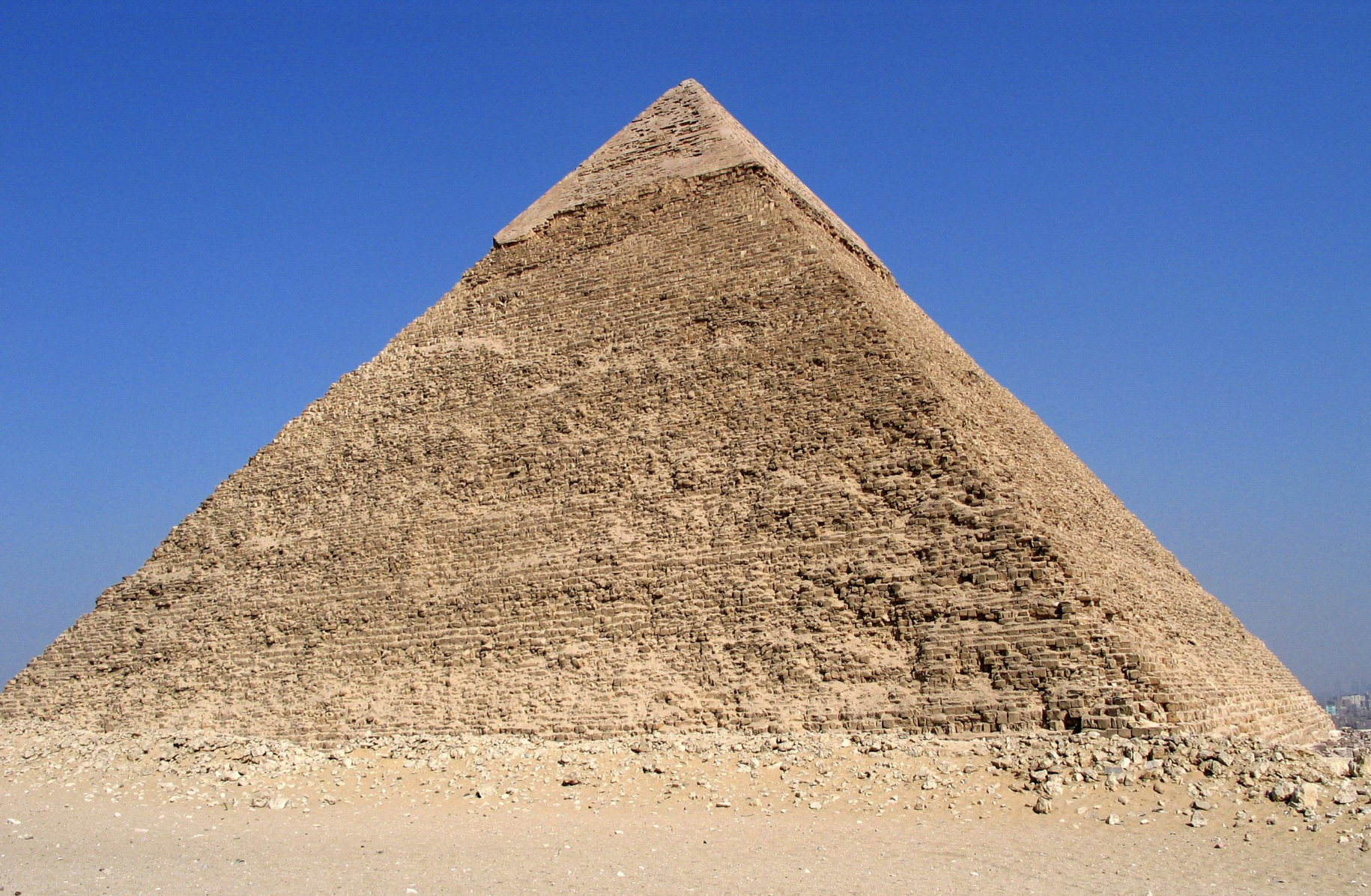
The Great Pyramid of Khufu
Architect: Possibly Hemiunu (vizier)
Title: Great Pyramid of Khufu
Medium: Limestone and granite
Date: c. 2589–2566 BCE
Context: Part of the Giza pyramid complex.
Period: Old Kingdom (4th Dynasty)
Commissioned by: Pharaoh Khufu
Subject Matter: Funerary monument
Purpose: Tomb for the pharaoh, ensuring passage to afterlife.
Iconography: Scale and shape = cosmic order, sun worship, eternal life.
Comparison: Largest and most complex of the Giza pyramids.
Interpretations: Symbol of divine kingship and architectural power.
Significance: Architectural marvel; represents zenith of pyramid-building in Egypt.
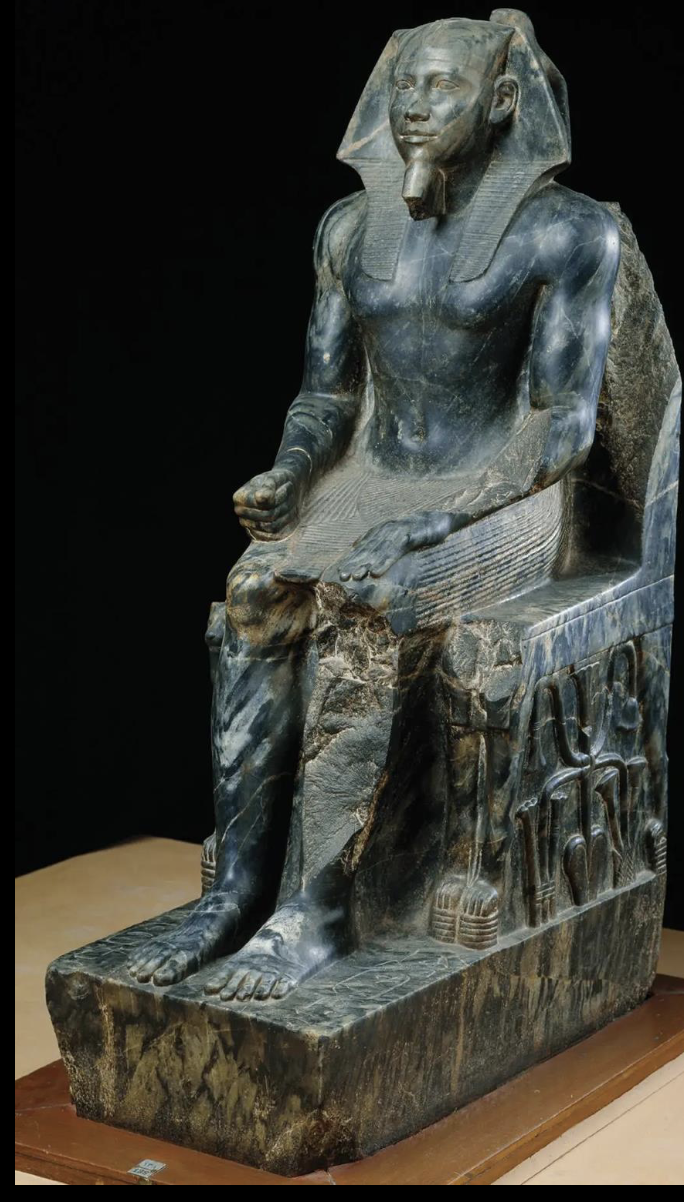
Khafre Enthroned
Artist: Unknown
Title: Khafre Enthroned
Medium: Gneiss
Date: c. 2520–2494 BCE
Context: Statue from valley temple near the Great Sphinx.
Period: Old Kingdom
Commissioned by: Pharaoh Khafre
Subject Matter: Idealized portrait of the seated king
Purpose: Ka statue to house the pharaoh’s soul.
Iconography: Horus falcon behind head, papyrus and lotus on throne = divine protection and unity.
Comparison: Similar to Menkaure and Queen in style and posture.
Interpretations: Emphasizes eternal perfection and divine authority.
Significance: Key example of Egyptian portraiture and divine kingship.
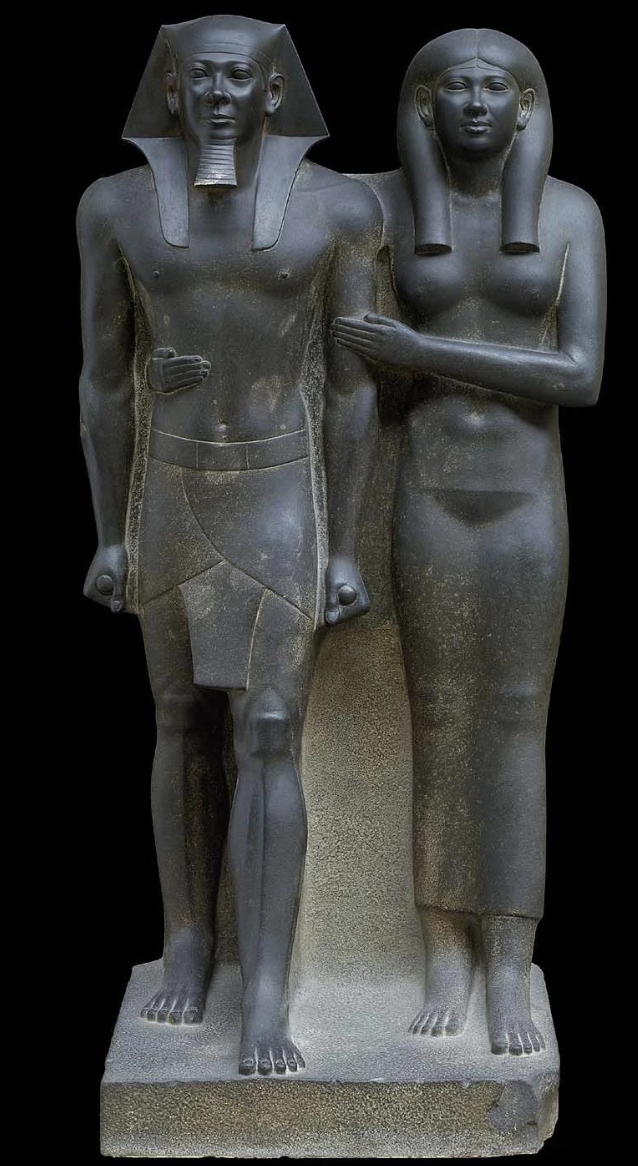
Menkaure and Queen
Artist: Unknown
Title: Menkaure and Queen
Medium: Graywacke
Date: c. 2490–2472 BCE
Context: Found in Menkaure’s valley temple at Giza.
Period: Old Kingdom
Commissioned by: Pharaoh Menkaure
Subject Matter: King and likely his wife or goddess Hathor.
Purpose: Funerary statue, eternal representation for ka.
Iconography: Formal posture, frontal stance = timeless presence.
Comparison: Slightly more naturalistic than Khafre Enthroned.
Interpretations: Balance of masculine power and feminine grace.
Significance: Symbol of royal unity, idealized forms, gender balance in kingship.
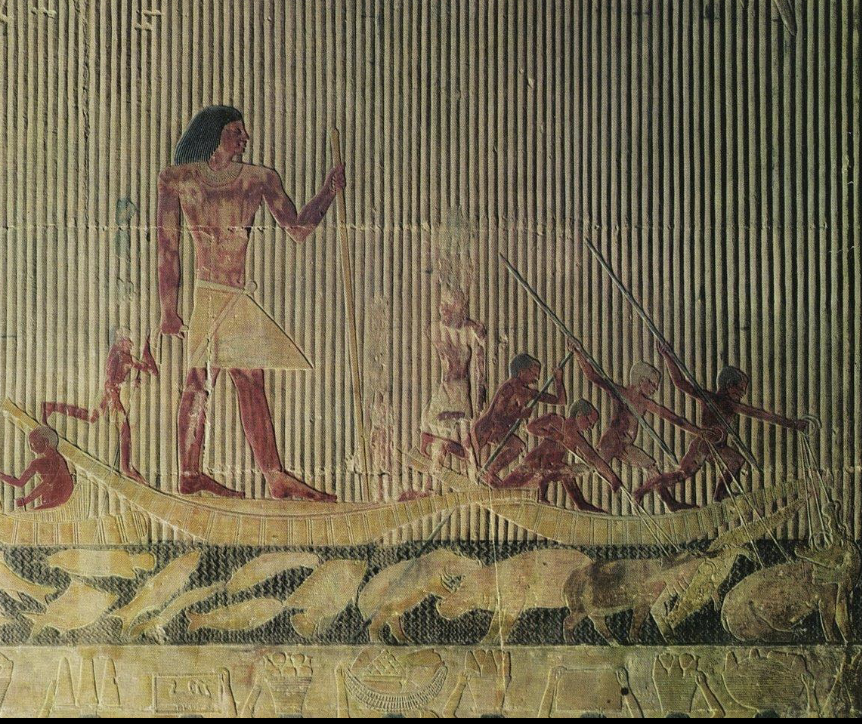
Ti Watching a Hippopotamus Hunt
Artist: Unknown
Title: Ti Watching a Hippopotamus Hunt
Medium: Painted limestone
Date: c. 2494–2345 BCE
Context: From tomb of Ti at Saqqara.
Period: Old Kingdom
Commissioned by: Ti, a government official
Subject Matter: Ti overseeing symbolic hunt.
Purpose: Ensure triumph over chaos in afterlife.
Iconography: Size hierarchy (Ti larger), orderly boats = power and order.
Comparison: Use of composite view and canon of proportions.
Interpretations: Metaphor for defeating evil/chaos.
Significance: Insight into non-royal funerary beliefs and social hierarchy.
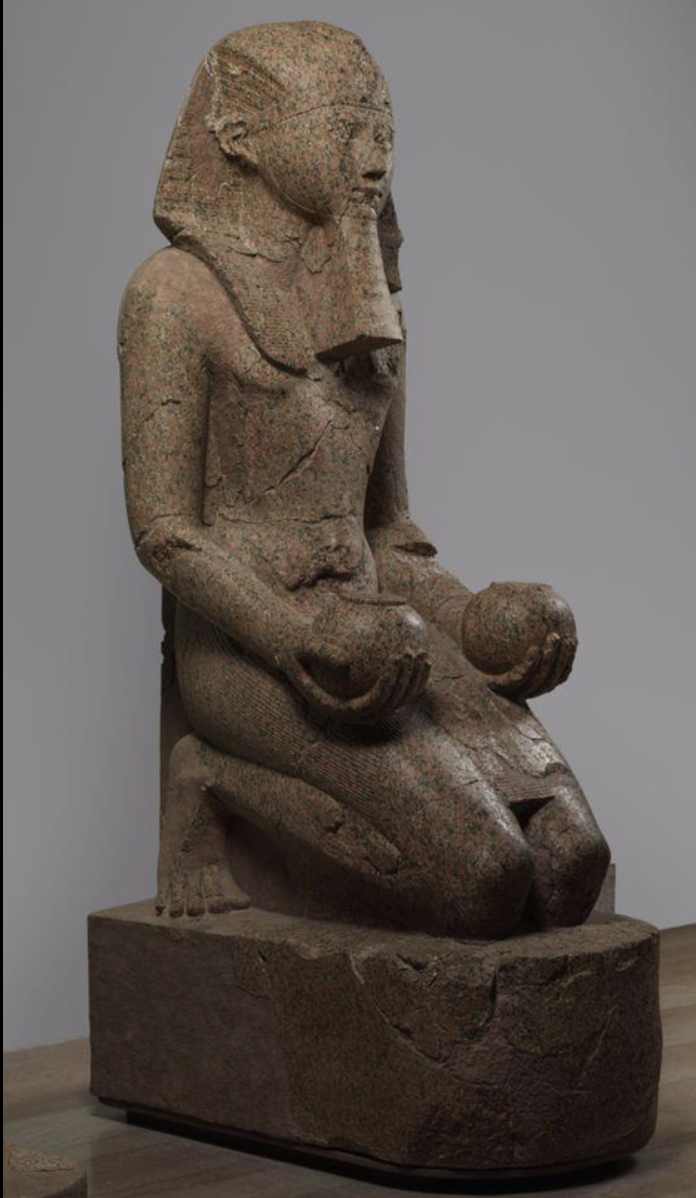
Hatshepsut Kneeling
Artist: Unknown
Title: Hatshepsut Kneeling
Medium: Red granite
Date: c. 1473–1458 BCE
Context: From her mortuary temple at Deir el-Bahri.
Period: New Kingdom
Commissioned by: Pharaoh Hatshepsut herself
Subject Matter: Female pharaoh offering to gods.
Purpose: Legitimize rule and show piety.
Iconography: Depicted with male regalia = authority; kneeling = humility to gods.
Comparison: Unique for gender representation in Egyptian art.
Interpretations: Blends gender roles to assert power.
Significance: Breaks gender norms in pharaonic representation.
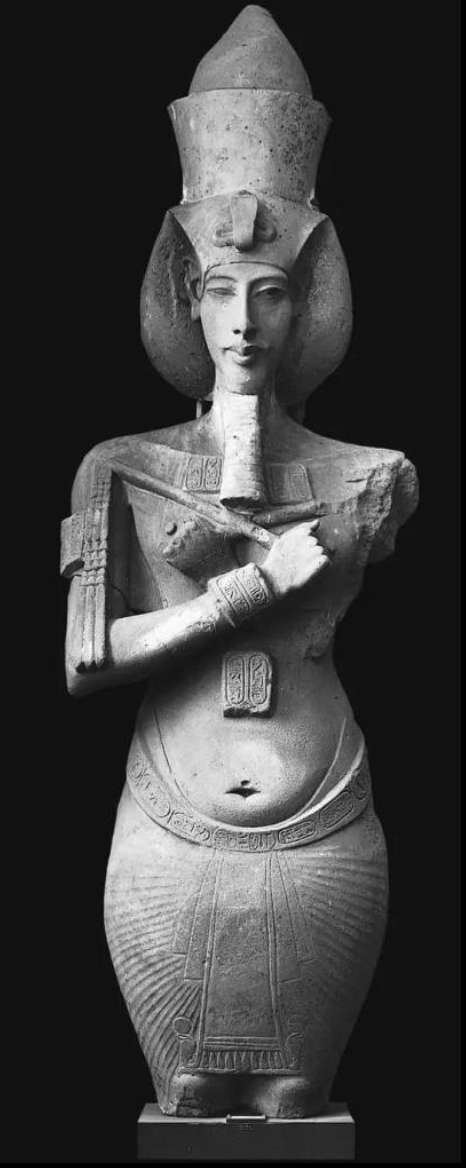
Colossal Statue of Akhenaten
Artist: Unknown
Title: Colossal Statue of Akhenaten
Medium: Sandstone
Date: c. 1352–1336 BCE
Context: From Akhenaten’s temple at Karnak.
Period: New Kingdom (Amarna Period)
Commissioned by: Akhenaten
Subject Matter: Radical portrayal of pharaoh
Purpose: Support monotheistic shift to Aten worship.
Iconography: Feminine curves, elongated face = rejection of tradition.
Comparison: Contrasts sharply with rigid Old Kingdom forms.
Interpretations: Some say it reflects a new theology; others suggest illness or style shift.
Significance: Visually embodies radical religious and cultural reform.
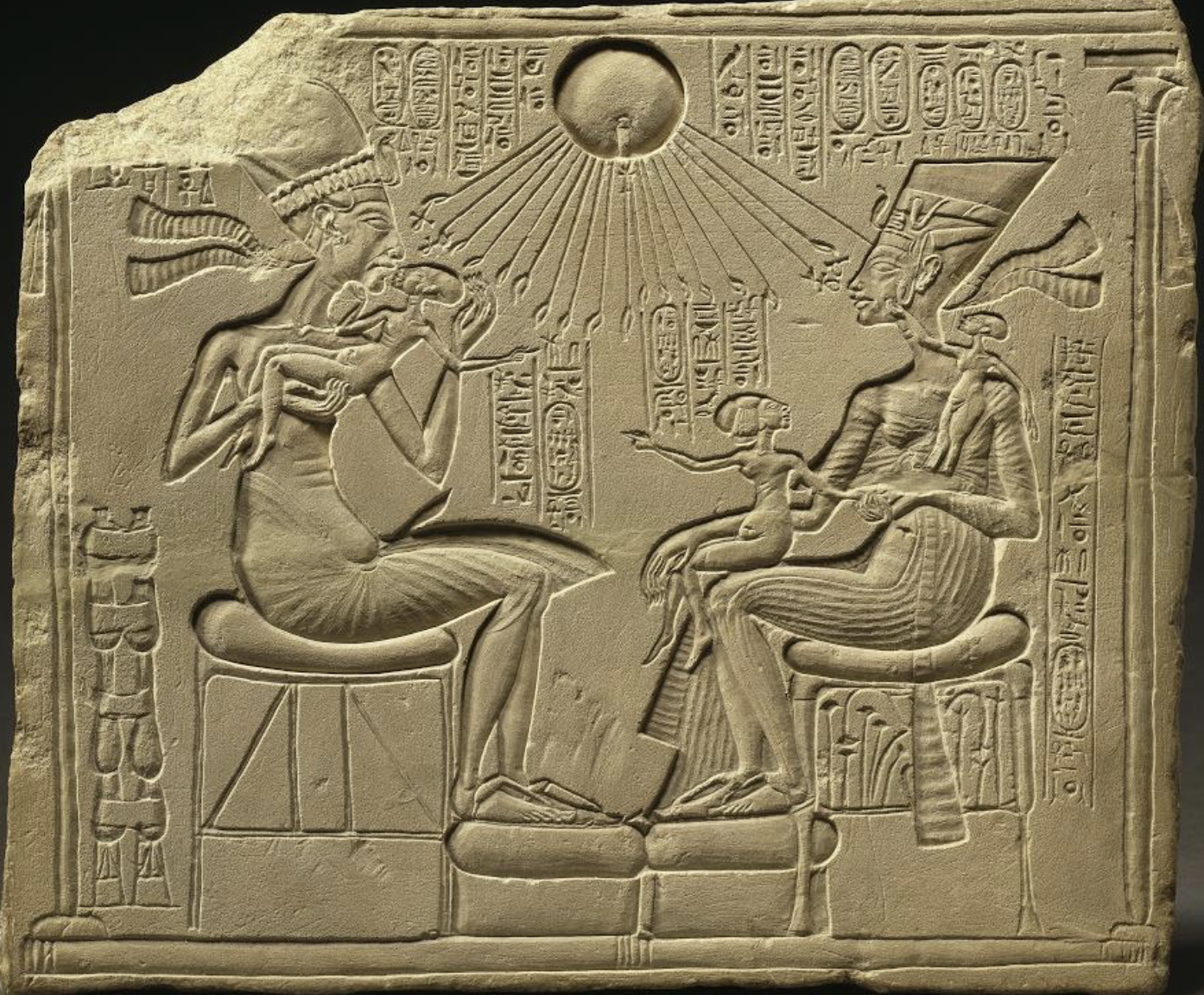
Stele of Akhenaten and His Family
Artist: Unknown
Title: Stele of Akhenaten and His Family
Medium: Limestone
Date: c. 1352–1336 BCE
Context: Private domestic relief
Period: Amarna Period
Commissioned by: Akhenaten or royal family
Subject Matter: Akhenaten, Nefertiti, and daughters under Aten
Purpose: Express new intimate, domestic spirituality.
Iconography: Sun disk (Aten) with rays ending in hands = divine blessing.
Comparison: More personal and informal than traditional royal art.
Interpretations: Highlights centrality of Aten and royal family in new religious order.
Significance: Shows shift to monotheism and emphasis on familial piety.
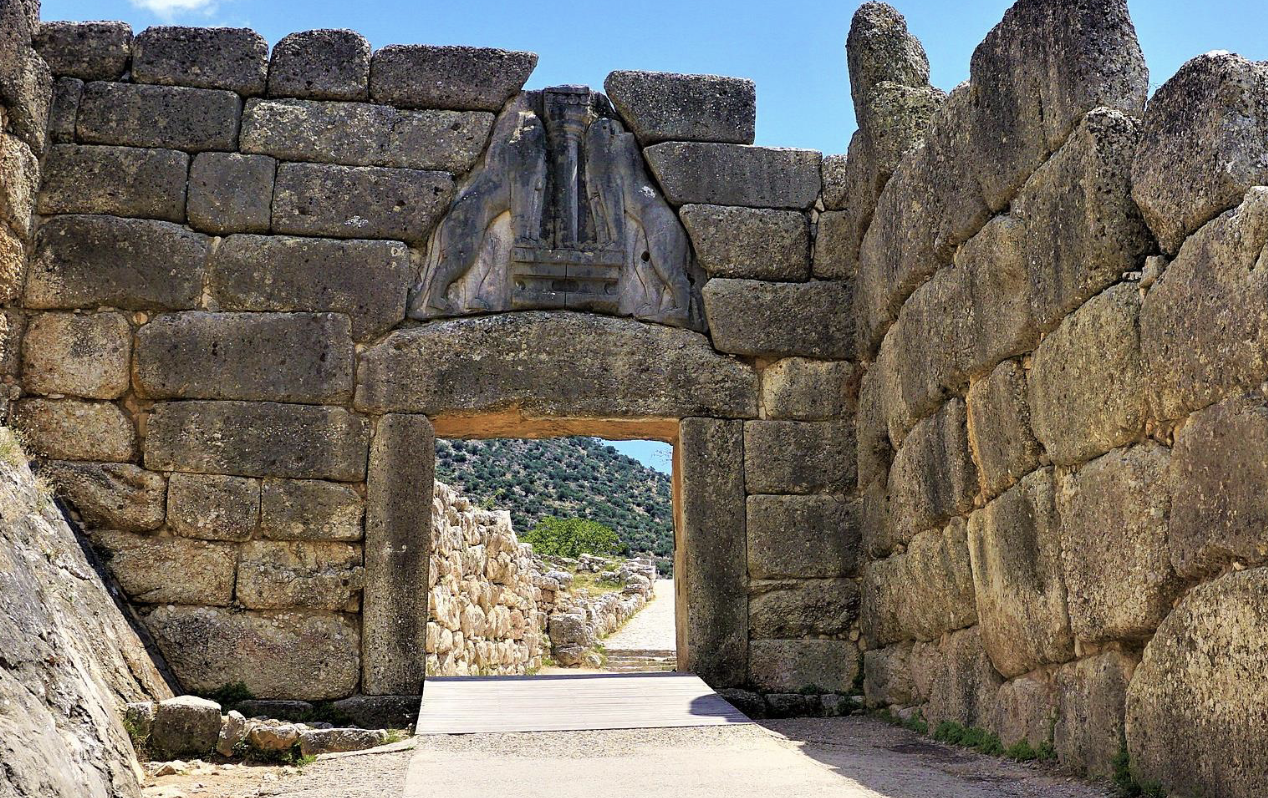
The Lion Gate, Mycenae
Architect: Unknown
Title: Lion Gate
Medium: Limestone
Date: c. 1250 BCE
Context: Main entrance to the citadel of Mycenae.
Period: Mycenaean (Late Bronze Age)
Commissioned by: Mycenaean rulers
Subject Matter: Heraldic lions flanking a column.
Purpose: Defensive entrance and royal propaganda.
Iconography: Lions = strength, column = palace or divine power.
Comparison: Among the earliest examples of monumental sculpture in Europe.
Interpretations: Symbolizes authority, control, and divine protection of the city.
Significance: Earliest example of monumental stone relief sculpture in mainland Greece.
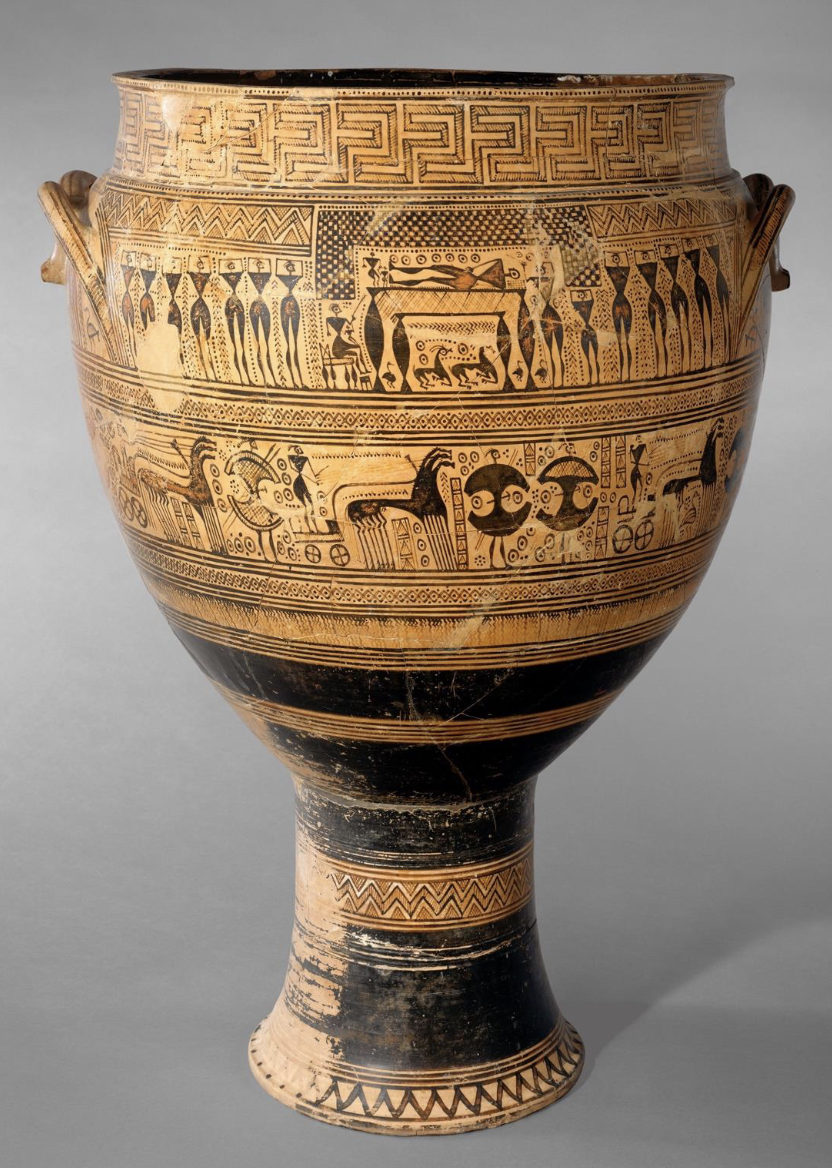
Dipylon Krater
Artist: Unknown
Title: Dipylon Krater
Medium: Ceramic
Date: c. 740 BCE
Context: Found at Dipylon cemetery, Athens.
Period: Geometric Period
Commissioned by: Athenian aristocracy
Subject Matter: Funeral scene and mourning figures.
Purpose: Grave marker and libation vessel.
Iconography: Abstract figures, meander patterns, funerary motifs.
Comparison: More narrative than earlier geometric works.
Interpretations: Emphasis on collective mourning, status display.
Significance: Shows development of narrative art and public commemoration.
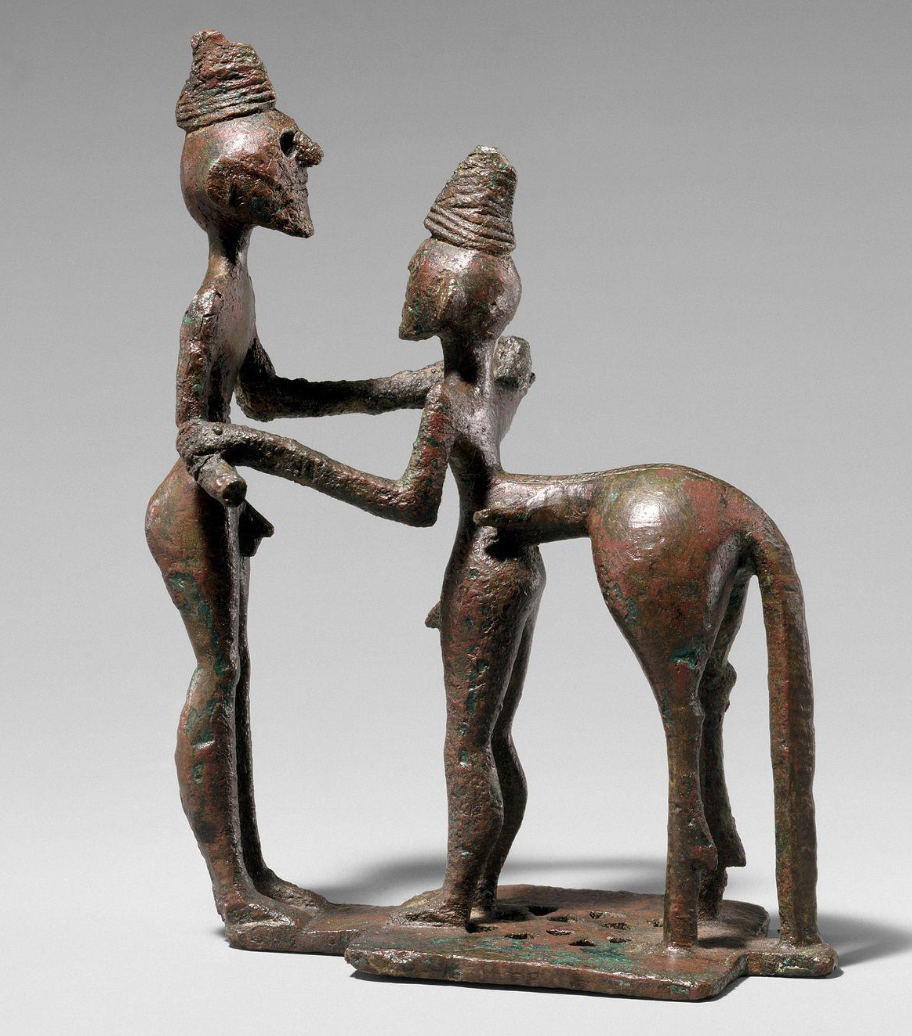
Man and Centaur
Artist: Unknown
Title: Man and Centaur
Medium: Bronze
Date: c. 750 BCE
Context: Found in Olympia.
Period: Geometric Period
Commissioned by: Unknown; possibly votive.
Subject Matter: Human figure and mythological centaur.
Purpose: Likely a votive offering.
Iconography: Conflict between man and beast = human struggle with chaos.
Comparison: Early integration of myth into sculpture.
Interpretations: Prefigures Greek heroic narratives and duality themes.
Significance: Shows myth entering artistic consciousness.

Temple of Hera I, Paestum
Architect: Unknown
Title: Temple of Hera I
Medium: Limestone with plaster
Date: c. 550–540 BCE
Context: Located in Magna Graecia (southern Italy)
Period: Archaic Greek
Commissioned by: Local Greek settlers
Subject Matter: Temple to Hera, goddess of marriage
Purpose: Religious worship
Iconography: Doric columns and central cella = divine order and protection.
Comparison: Massive columns, close spacing typical of early Doric style.
Interpretations: Reflects community wealth and divine patronage.
Significance: Important example of early Doric temple architecture.
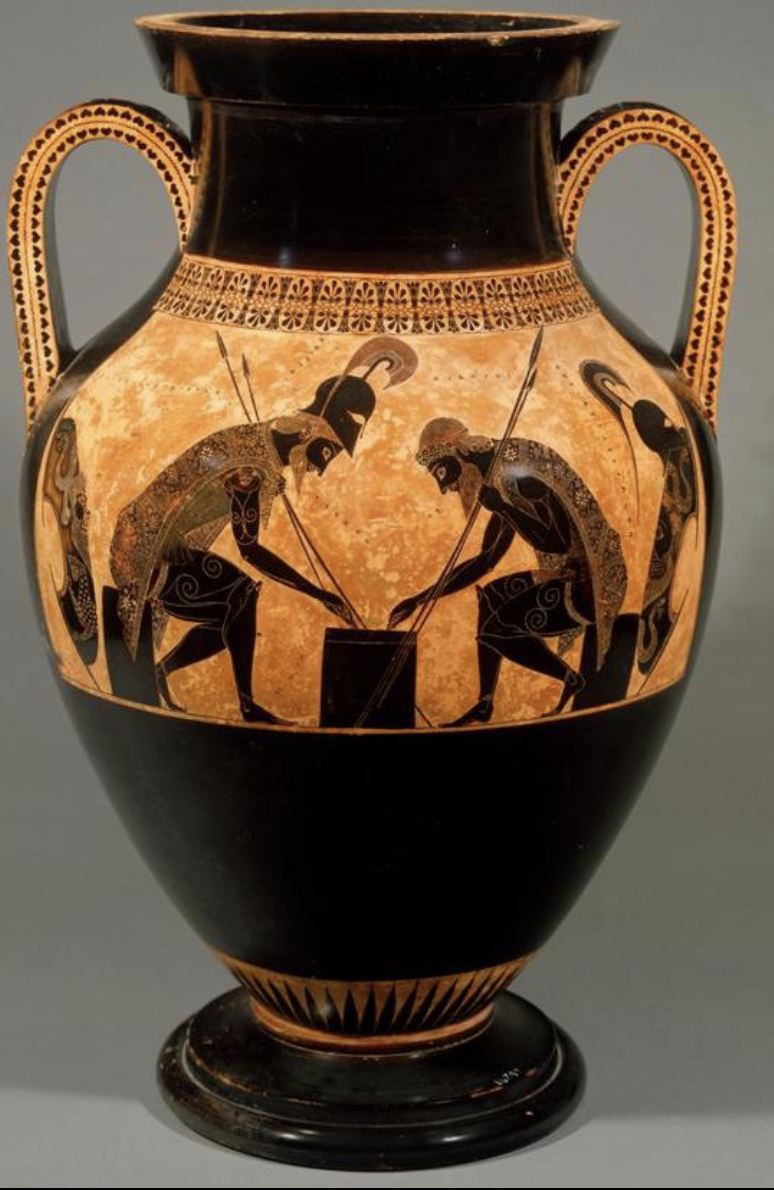
Exekias, Ajax and Achilles Playing a Game
Artist: Exekias
Title: Ajax and Achilles Playing a Game
Medium: Ceramic amphora
Date: c. 550–540 BCE
Context: Found in Etruscan tombs; made in Athens.
Period: Archaic Greek
Commissioned by: Likely for export to elite buyers.
Subject Matter: Ajax and Achilles in a moment of calm before battle.
Purpose: Mixing wine; also aesthetic and symbolic.
Iconography: Spear tips and gaze guide attention; shields symbolize war.
Comparison: More narrative and psychological than earlier vases.
Interpretations: Emphasizes humanity of heroes, foreshadows tragedy.
Significance: Masterpiece of black-figure pottery and Greek storytelling.
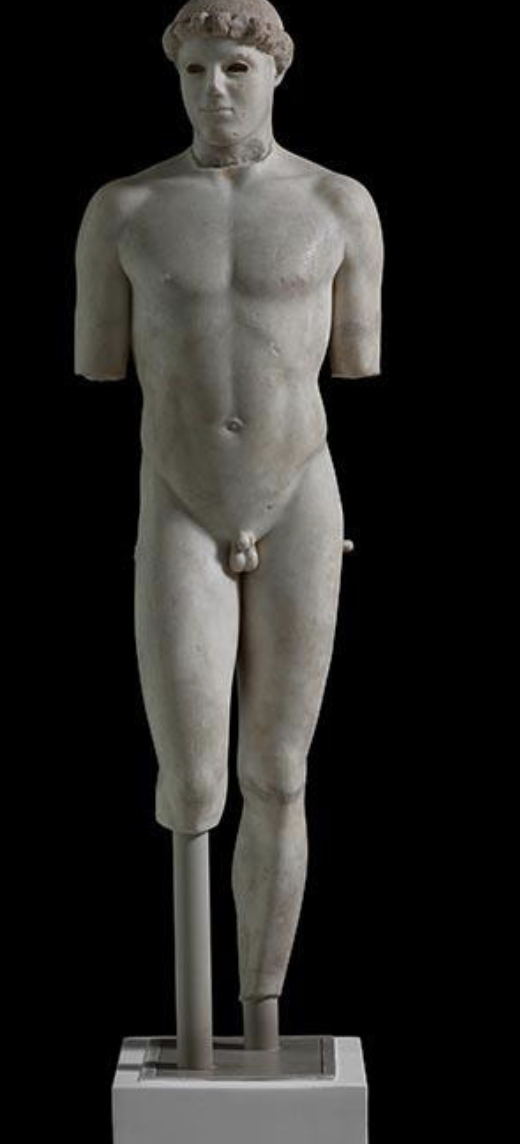
Kritios Boy
Artist: Unknown
Title: Kritios Boy
Medium: Marble
Date: c. 480 BCE
Context: Found on the Acropolis of Athens.
Period: Early Classical (Severe Style)
Commissioned by: Unknown; possibly public or temple context.
Subject Matter: Idealized youth
Purpose: Demonstrates naturalistic form and contrapposto.
Iconography: Transition from Archaic stiffness to Classical realism.
Comparison: Break from kouros type (e.g., New York Kouros).
Interpretations: Early step toward individualized, lifelike statuary.
Significance: Marks a turning point in sculptural realism.
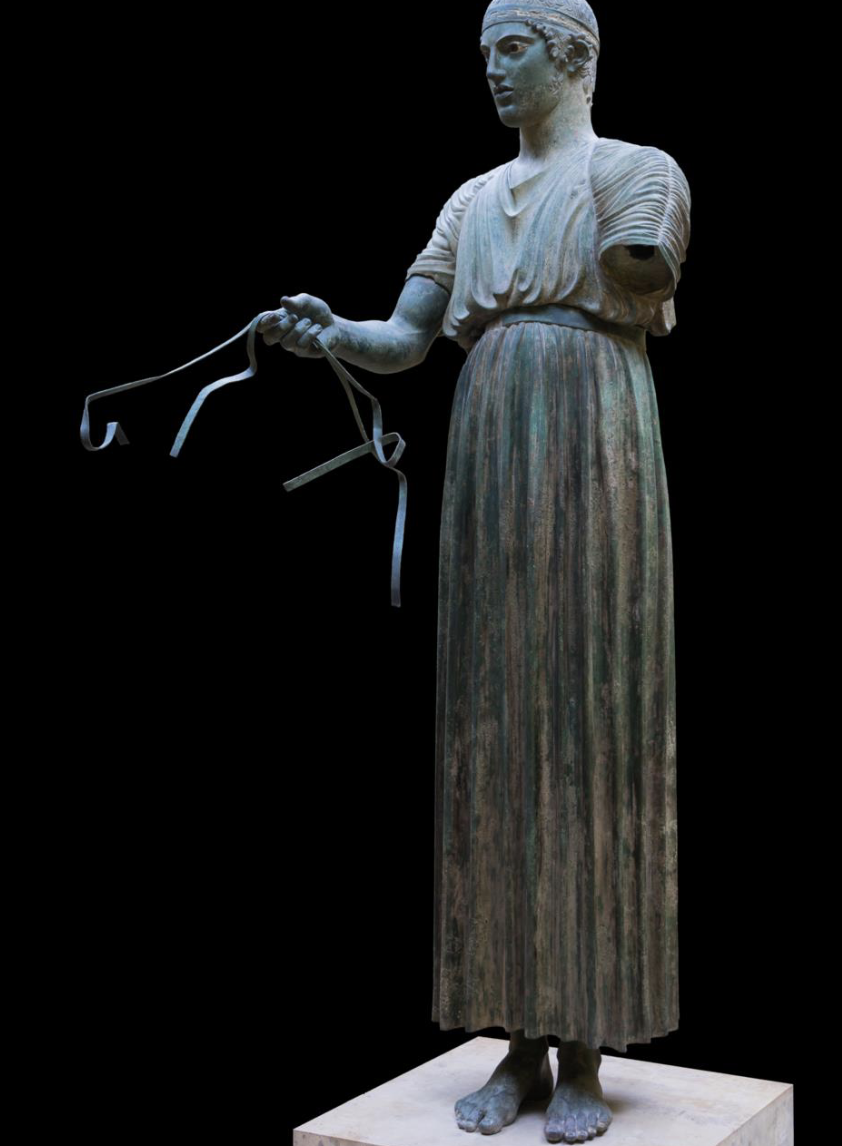
Charioteer of Delphi
Artist: Unknown
Title: Charioteer of Delphi
Medium: Bronze with silver details
Date: c. 478–474 BCE
Context: Dedicated at the Sanctuary of Apollo, Delphi.
Period: Early Classical
Commissioned by: Polyzalos of Gela (Sicilian ruler)
Subject Matter: Victor in a chariot race
Purpose: Commemorative, religious offering.
Iconography: Calm dignity, self-restraint = Classical virtues.
Comparison: Contrasts with dynamic works like Artemision Zeus.
Interpretations: Represents ideal moral and physical form.
Significance: Rare bronze original; embodies Classical restraint and poise.
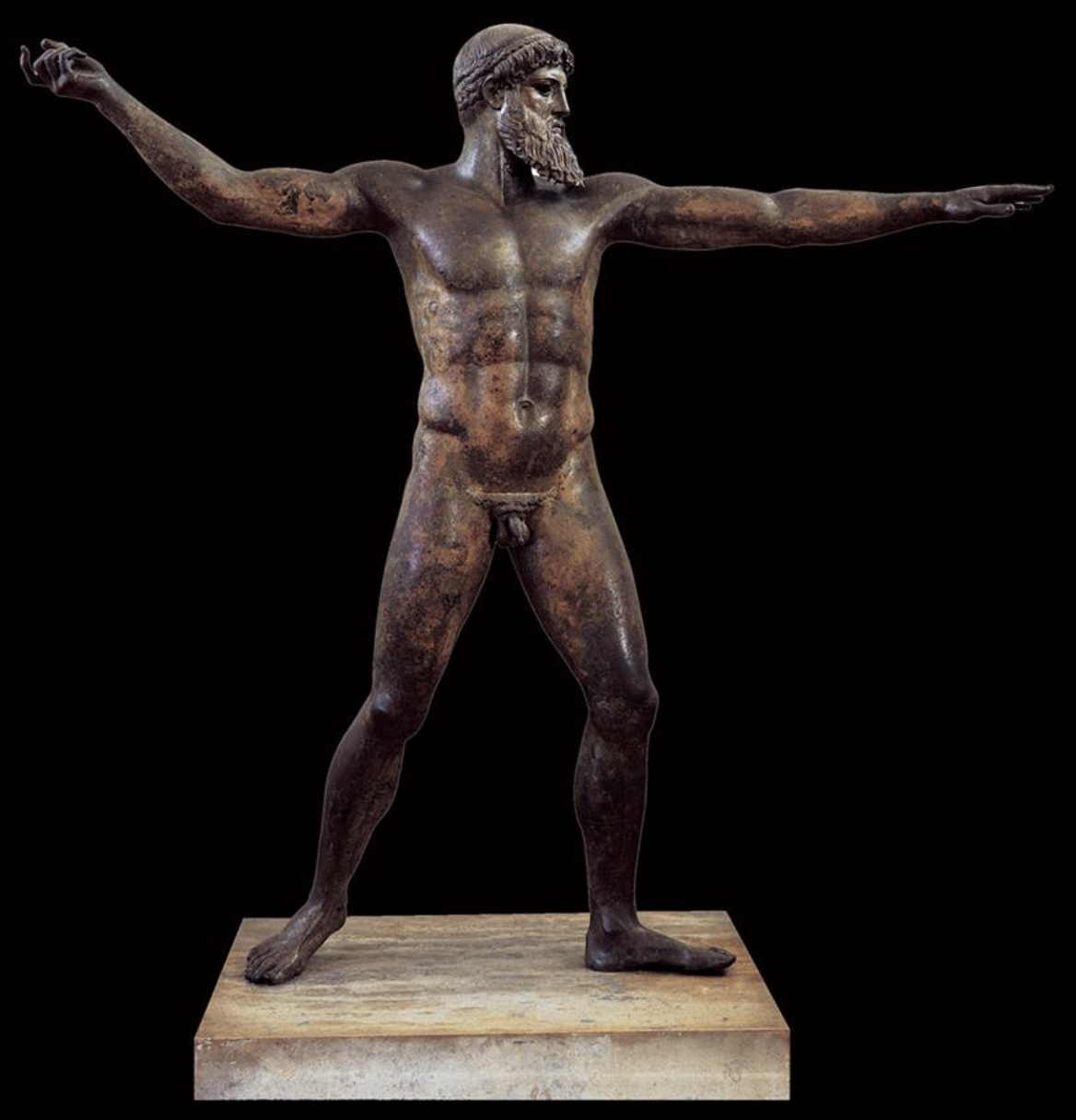
Artemision Zeus (or Poseidon)
Artist: Unknown
Title: Artemision Zeus (or Poseidon)
Medium: Bronze
Date: c. 460 BCE
Context: Found in sea off Cape Artemision.
Period: Early Classical
Commissioned by: Unknown
Subject Matter: God (likely Zeus or Poseidon) hurling a weapon
Purpose: Public display, religious reverence
Iconography: Dynamic motion, divine authority.
Comparison: Opposite of Kritios Boy in energy and scale.
Interpretations: Expression of divine power in human form.
Significance: Exemplifies balance of motion and stillness in Classical sculpture.
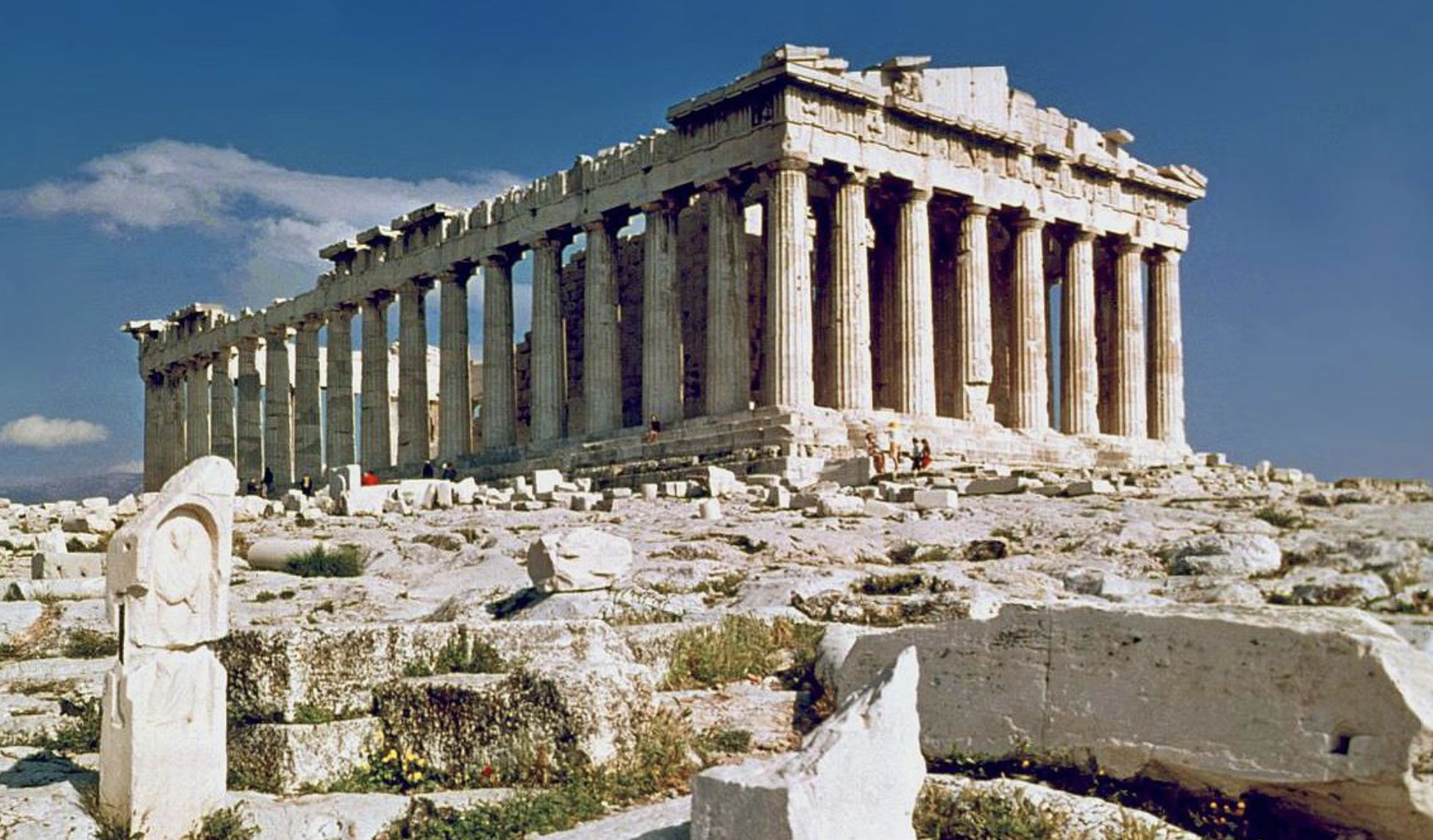
Kalikrates and Iktinos, Parthenon
Architects: Kalikrates and Iktinos
Title: Parthenon
Medium: Marble
Date: 447–432 BCE
Context: Temple to Athena on Athenian Acropolis.
Period: High Classical
Commissioned by: Pericles, funded by Delian League
Subject Matter: Athena, city of Athens, mythological scenes
Purpose: Civic pride, religious worship, political dominance
Iconography: Metopes, frieze, and pediments = mythology and historical identity
Comparison: Culmination of Doric architecture, optical refinements.
Interpretations: Political and religious symbol of Athenian greatness.
Significance: Peak of Classical Greek architecture; synthesis of form, function, and ideology.
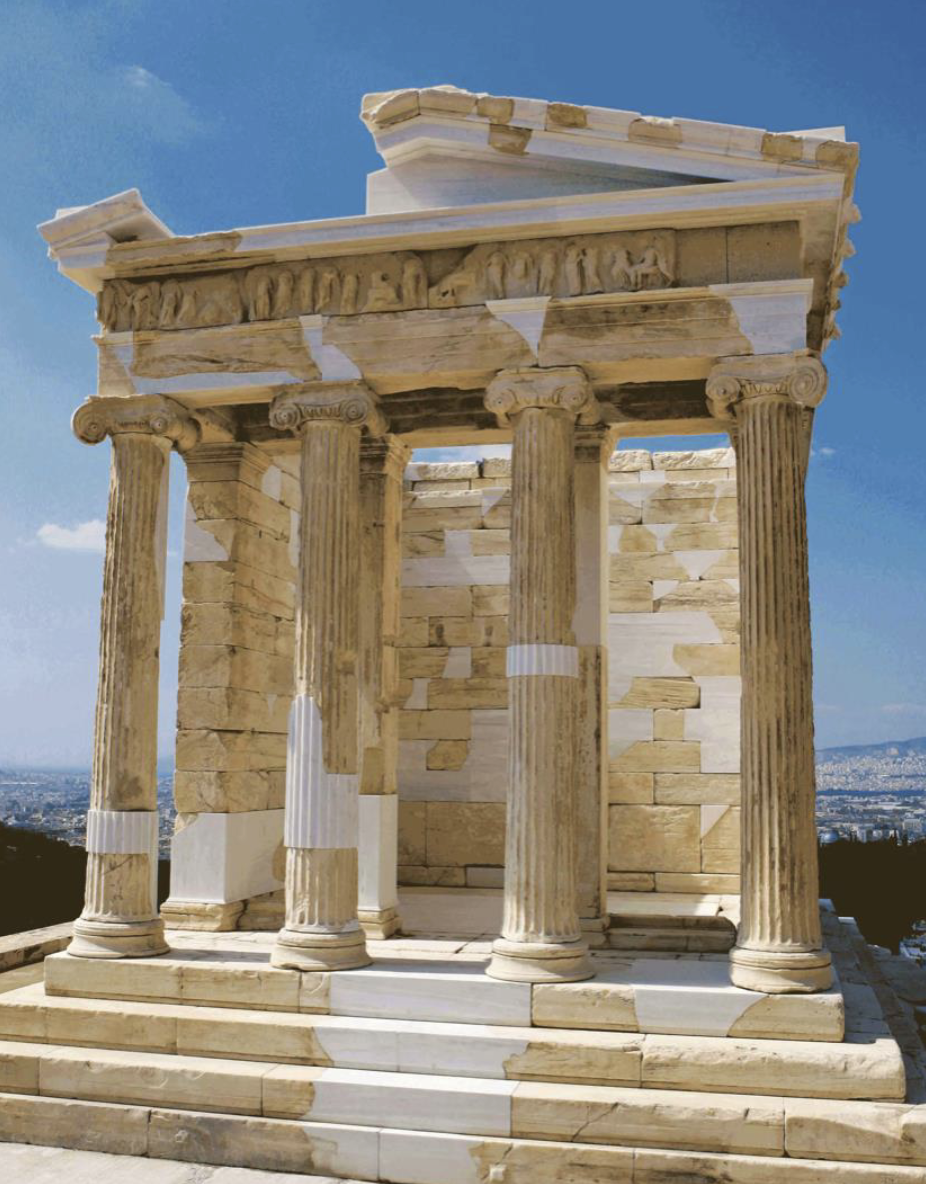
Kalikrates, Temple of Athena Nike
Architect: Kalikrates
Title: Temple of Athena Nike
Medium: Marble
Date: 421–415 BCE
Context: On the Acropolis, overlooking entrance.
Period: High Classical
Commissioned by: Periclean Athens
Subject Matter: Athena as bringer of victory.
Purpose: Commemorate military success.
Iconography: Ionic elegance; frieze shows battle scenes.
Comparison: Smaller, more graceful than Parthenon.
Interpretations: Celebrates civic and military identity.
Significance: Blends religious reverence with political narrative.
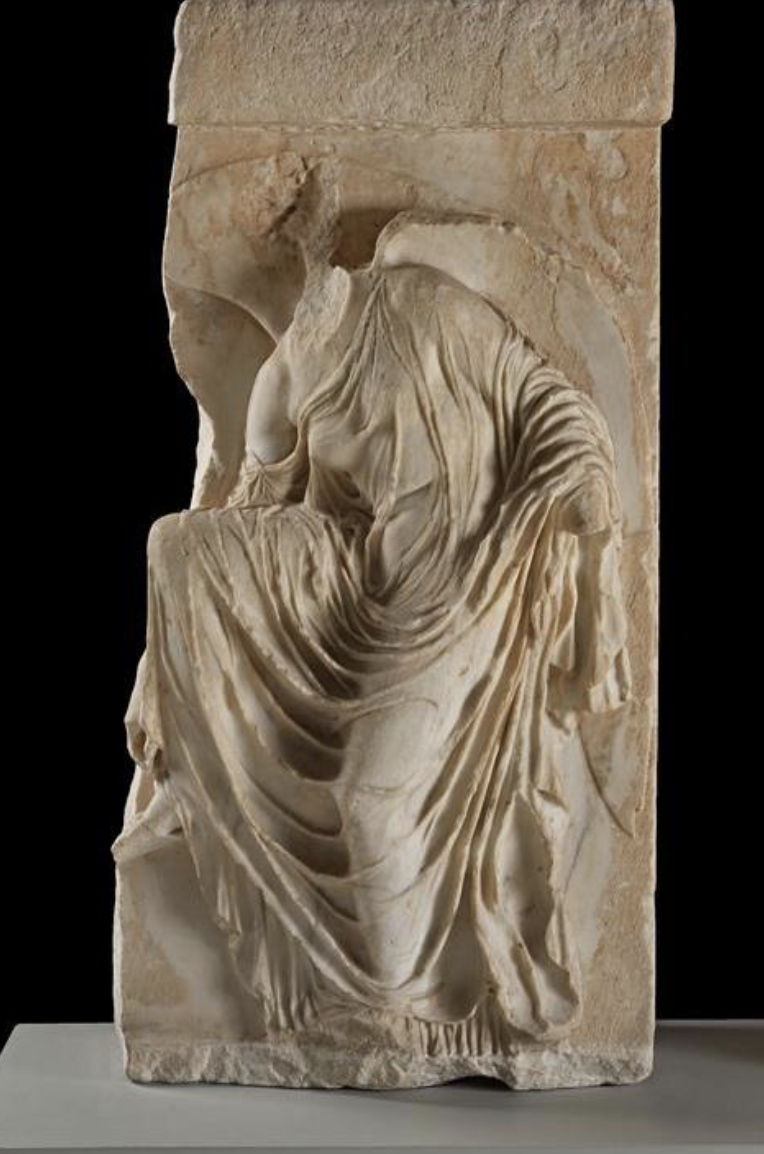
Nike Adjusting Her Sandal
Artist: Unknown
Title: Nike Adjusting Her Sandal
Medium: Marble
Date: 407 BCE
Context: From parapet of Temple of Athena Nike.
Period: High Classical
Commissioned by: Athenian city-state
Subject Matter: Winged goddess in intimate moment.
Purpose: Decorative relief; aesthetic and symbolic.
Iconography: Wet drapery technique reveals form beneath clothing.
Comparison: Humanized divine figure; more sensual than earlier representations.
Interpretations: Shows Classical ideals of beauty, grace.
Significance: Example of stylistic shift toward more natural and intimate depictions.
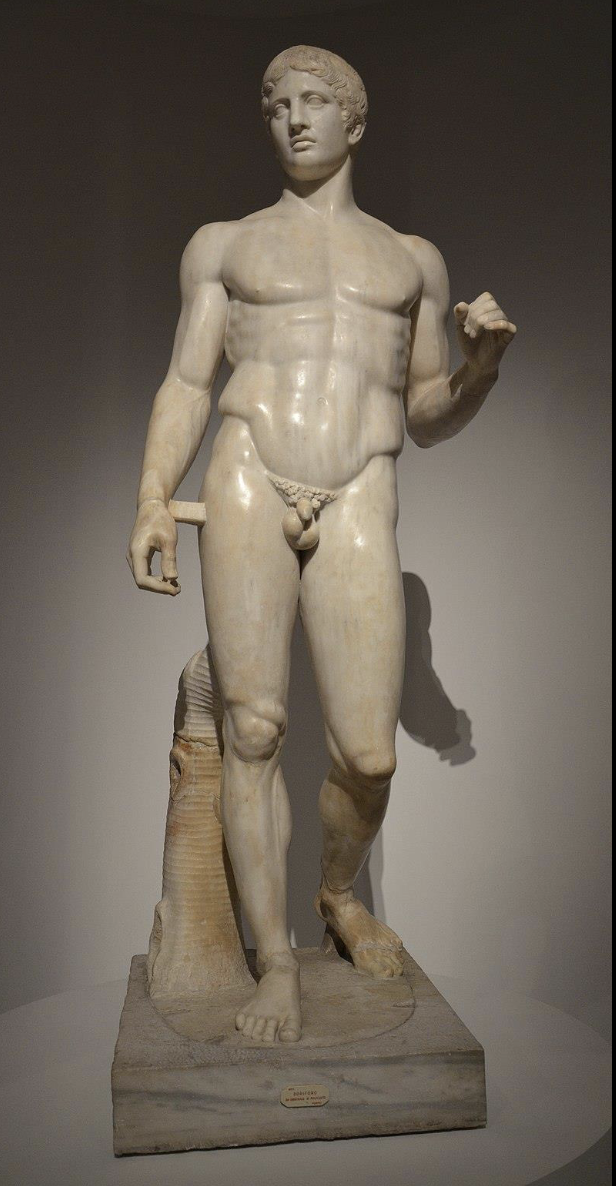
Polykleitos, Doryphoros (Spear Bearer)
Artist: Polykleitos
Title: Doryphoros (Roman copy of Greek original)
Medium: Marble
Date: c. 440 BCE
Context: Originally bronze; Roman copy survives.
Period: High Classical
Commissioned by: Possibly for athletic or educational setting.
Subject Matter: Ideal male athlete
Purpose: Demonstration of "Canon" of proportions.
Iconography: Contrapposto, balance, and symmetry.
Comparison: Influential on later sculptures (e.g., Augustus of Prima Porta).
Interpretations: Embodies Polykleitos’s theories of beauty and proportion.
Significance: Model of ideal male form and Classical rationalism.
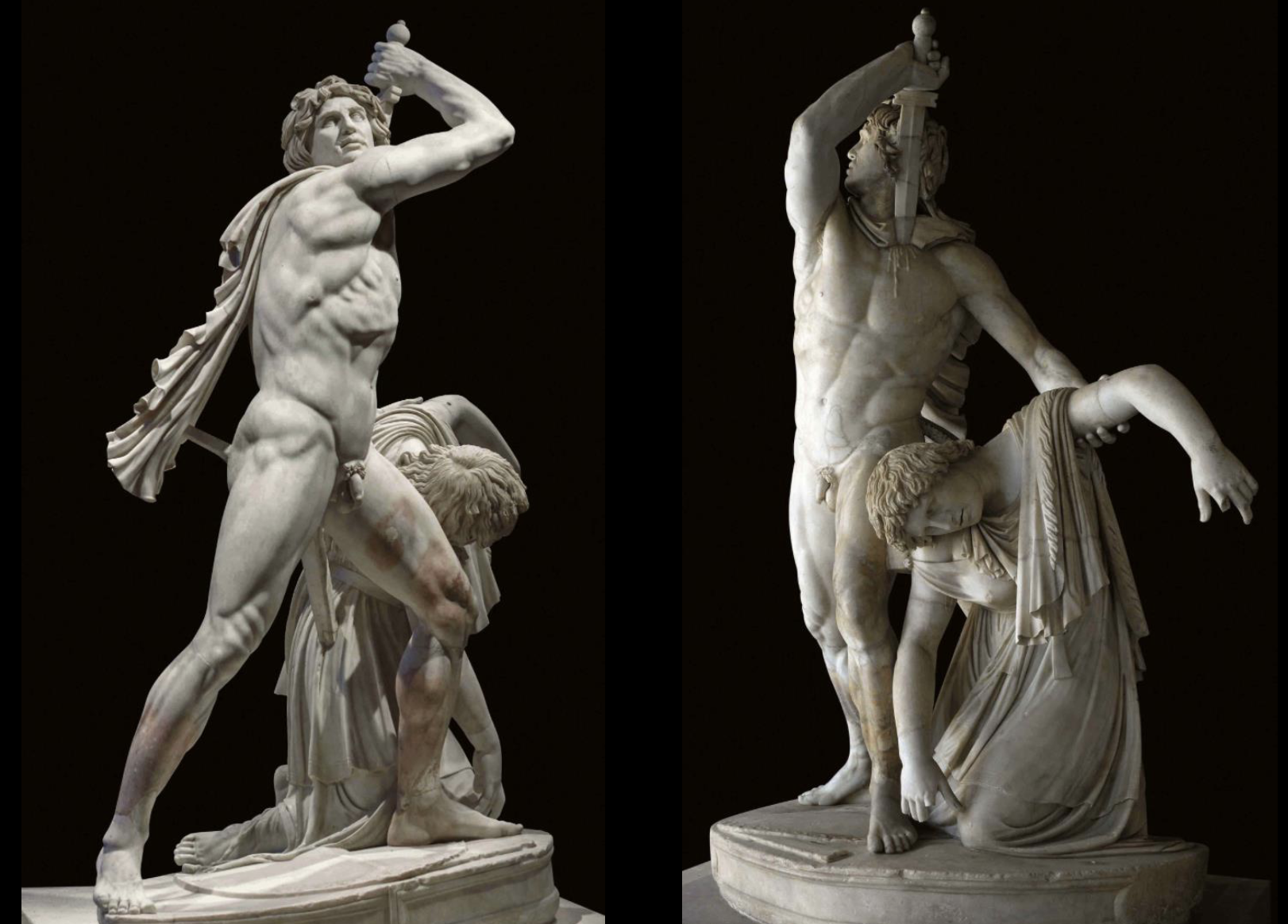
Epigonos, Ludovisi Gaul (Gaul Killing Himself and His Wife)
Artist: Epigonos (attributed)
Title: Ludovisi Gaul
Medium: Marble (Roman copy of bronze original)
Date: c. 230 BCE
Context: Hellenistic sculpture commemorating Pergamene victory over Gauls.
Period: Hellenistic
Commissioned by: Attalid kings of Pergamon
Subject Matter: Defeated warrior’s final act
Purpose: Celebrate victory while honoring courage of the enemy.
Iconography: Emotional realism, dynamic tension, pathos.
Comparison: Contrasts with calm dignity of Classical works like Doryphoros.
Interpretations: Noble death, tragic heroism.
Significance: Exemplifies emotional power and dramatic style of Hellenistic art.